Mathea Ford's Blog, page 8
December 24, 2024
Chicken and Broccoli with Cashews
Looking for a flavorful, CKD-friendly dinner thatâs easy to make and packed with nutritious ingredients? This Cashew Chicken and Broccoli Stir Fry combines tender chicken, crunchy cashews, and vibrant broccoli in a savory, low-sodium sauce thatâs perfect for maintaining kidney health. Whether served over rice or noodles, this dish offers a delicious way to enjoy a balanced meal without compromising on flavor or dietary needs.
As a Registered Dietitian Nutritionist specializing in chronic kidney disease, I have years of experience helping individuals manage their health through tailored dietary plans. My expertise in crafting CKD-friendly recipes ensures that each dish prioritizes kidney health while remaining flavorful and enjoyable. Through evidence-based guidance and practical advice, Iâm committed to empowering others to make informed, kidney-friendly food choices.
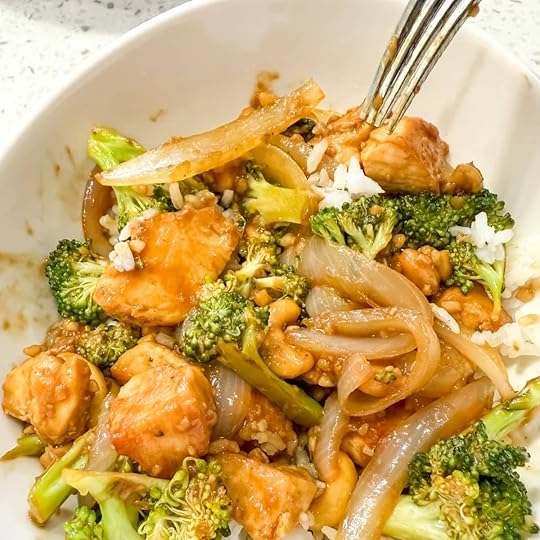
This Cashew Chicken and Broccoli Stir Fry is carefully crafted to support a CKD-friendly diet by using low-sodium ingredients like vinegar and chicken broth while avoiding high-potassium vegetables, as well as minimizing higher sodium ingredients. Lean chicken provides essential protein without overloading phosphorus levels, and the moderate use of broccoli ensures a healthy dose of fiber and antioxidants. With thoughtful ingredient choices, this recipe delivers both nutrition and flavor, making it an excellent option for kidney health.
My other chicken and broccoli pasta bake is a delicious meal, as well as our steak sliders. You can find all kinds of kidney friendly chicken dishes on our blog. We love pairing this with a yummy salad like our corn pasta salad and a delicious dessert like our dairy free creme brulee.
[feast_advanced_jump_to]Ingredients For Low Sodium Stir Fry SauceThis Cashew Chicken and Broccoli Stir Fry comes together with a simple combination of fresh, kidney-friendly ingredients like tender chicken, crisp broccoli, and crunchy cashews, all brought together with a flavorful low-sodium sauce. Each ingredient is carefully chosen to create a balanced, delicious meal thatâs easy to prepare and perfect for those managing CKD.
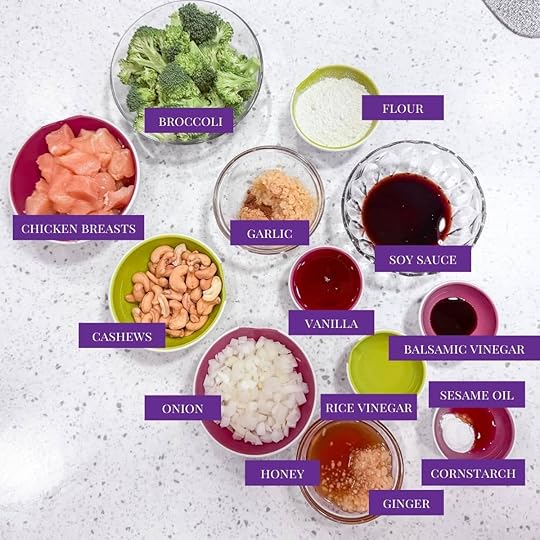 Boneless, skinless chicken breasts â A lean protein source that is low in phosphorus and sodium, making it suitable for CKD diets.Flour â Used for coating the chicken, providing a light crust without adding excessive sodium or fat.Sesame oil â Adds a rich, nutty flavor and healthy fats while keeping sodium content minimal.Broccoli florets â A nutrient-rich vegetable low in potassium when consumed in moderation, offering fiber and antioxidants.Sliced onion â Enhances flavor naturally without the need for additional sodium.No added salt cashews â A heart-healthy nut providing crunch and healthy fats while keeping sodium levels low.Minced garlic â A flavorful, kidney-friendly ingredient that enhances taste and offers anti-inflammatory benefits.Ground ginger â Adds a warm, zesty flavor with potential anti-inflammatory and digestive health benefits.Sauce IngredientsLow sodium soy sauce â Provides savory flavor with significantly less sodium compared to regular soy sauce.Balsamic vinegar â Adds tangy sweetness and depth of flavor without increasing sodium.Honey â Balances the savory elements with a touch of natural sweetness.Rice vinegar â Contributes a mild acidity to brighten the dish without adding excess sodium.Sesame oil â Adds continuity in flavor from the stir fry to the sauce while keeping the recipe kidney-friendly.Minced garlic â Provides a unifying aromatic element between the stir fry and sauce.Low sodium chicken broth â Creates a base for the sauce while minimizing sodium content.Cornstarch â Helps thicken the sauce naturally without adding additional sodium or fat.
Boneless, skinless chicken breasts â A lean protein source that is low in phosphorus and sodium, making it suitable for CKD diets.Flour â Used for coating the chicken, providing a light crust without adding excessive sodium or fat.Sesame oil â Adds a rich, nutty flavor and healthy fats while keeping sodium content minimal.Broccoli florets â A nutrient-rich vegetable low in potassium when consumed in moderation, offering fiber and antioxidants.Sliced onion â Enhances flavor naturally without the need for additional sodium.No added salt cashews â A heart-healthy nut providing crunch and healthy fats while keeping sodium levels low.Minced garlic â A flavorful, kidney-friendly ingredient that enhances taste and offers anti-inflammatory benefits.Ground ginger â Adds a warm, zesty flavor with potential anti-inflammatory and digestive health benefits.Sauce IngredientsLow sodium soy sauce â Provides savory flavor with significantly less sodium compared to regular soy sauce.Balsamic vinegar â Adds tangy sweetness and depth of flavor without increasing sodium.Honey â Balances the savory elements with a touch of natural sweetness.Rice vinegar â Contributes a mild acidity to brighten the dish without adding excess sodium.Sesame oil â Adds continuity in flavor from the stir fry to the sauce while keeping the recipe kidney-friendly.Minced garlic â Provides a unifying aromatic element between the stir fry and sauce.Low sodium chicken broth â Creates a base for the sauce while minimizing sodium content.Cornstarch â Helps thicken the sauce naturally without adding additional sodium or fat.See recipe card for quantities.
How To Make Low Sodium Stir FryNow that you have all your ingredients ready, letâs walk through the simple steps to bring this delicious Cashew Chicken and Broccoli Stir Fry to life. With just a few quick actions, youâll have a flavorful, kidney-friendly meal ready in no time.
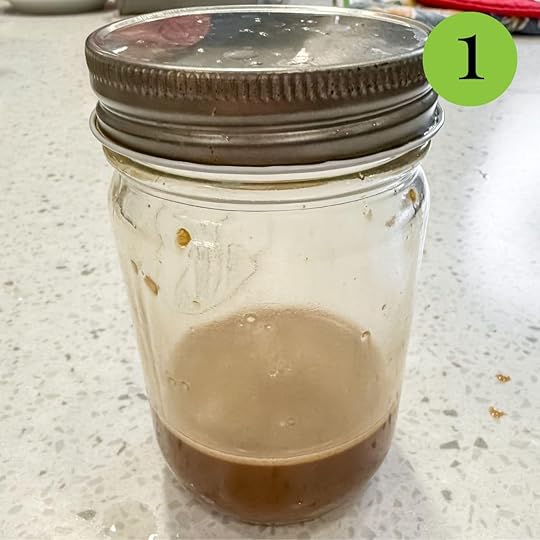
1. Prepare the sauce - add all of the ingredients to a bowl, and mix well. Set aside.
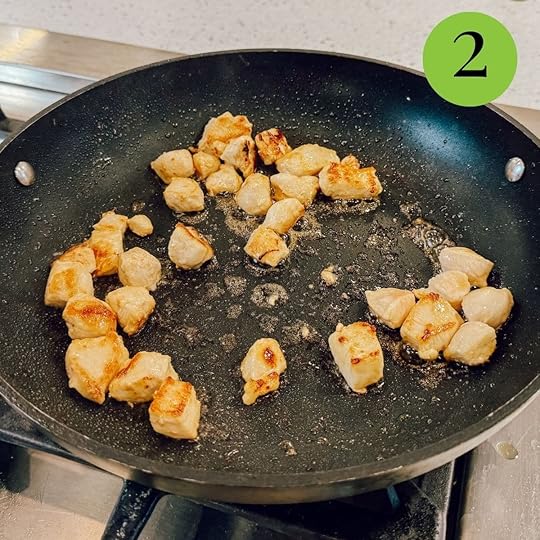
2. Dice the chicken into 1 in or smaller pieces. Dredge the chicken pieces in flour to coat them.
3. Add 1 tablespoon sesame oil to large skillet over medium heat. Add the chicken and saute, tossing occasionally, for 5-7 minutes or until thoroughly cooked. Transfer to a plate and set aside.
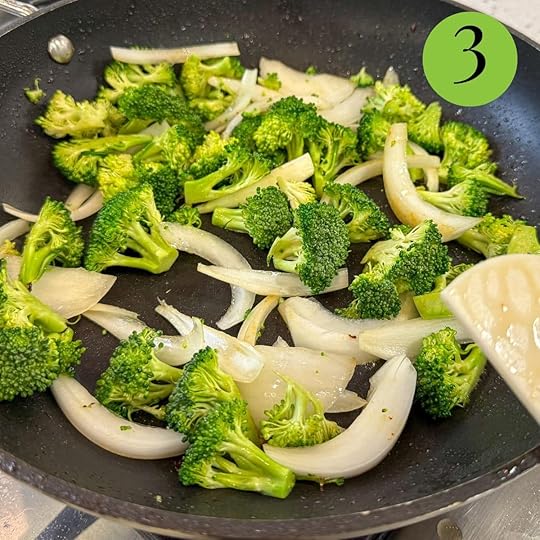
4. Add the remaining tablespoon of sesame oil to the pan over medium heat. Add the broccoli and onion and saute for 6-8 minutes.
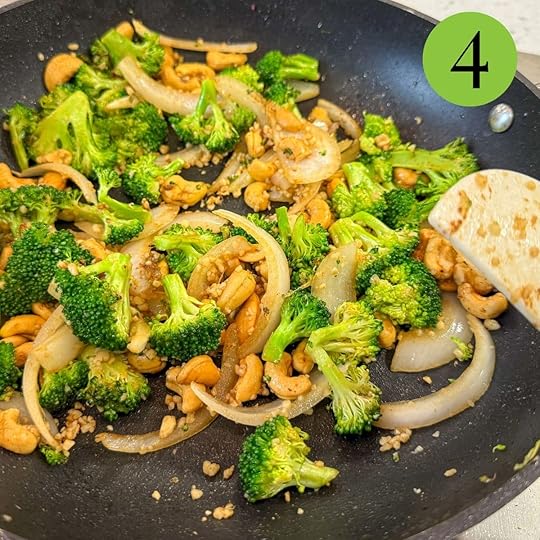
5. Add the cashews, garlic and ginger and saute for another 2-3 minutes or until the broccoli reaches your desired level of tenderness.
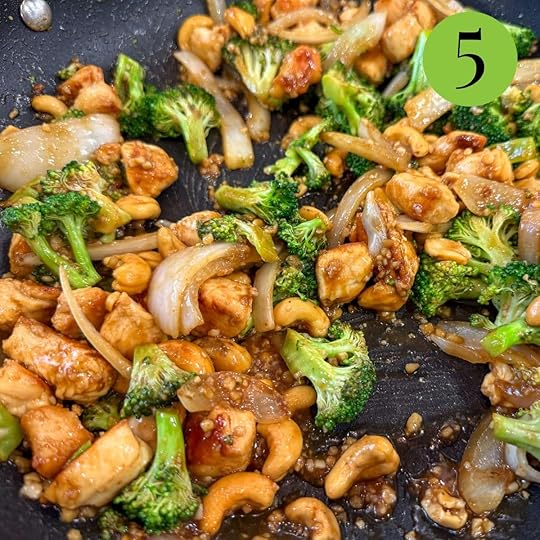
5. Combine the sauce and cooked chicken with the broccoli mixture and toss together for 1 minute. Continue to cook until the sauce thickens and evenly coats the vegetables.
6. Serve over noodles or rice as desired. Rice or noodles is not included in the nutritional information for this recipe.
Hint: Ensure Low Sodium in Cashews: Always opt for unsalted cashews, as salted versions can significantly increase the sodium content of the dish.
VariationsThis Cashew Chicken and Broccoli Stir Fry is versatile, and there are plenty of ways to adapt it for different tastes and dietary needs. Here are a few variations that maintain its kidney-friendly qualities:
Spicy Kick: For those who enjoy heat, add a pinch of chili flakes or a splash of hot sauce to the stir fry for extra flavor without compromising kidney health.Vegetarian Version: Replace the chicken with tofu or tempeh for a plant-based protein alternative thatâs low in sodium and phosphorus.Add More Veggies: Consider adding other low-potassium vegetables like bell peppers, zucchini, or snap peas to enhance the dishâs nutritional value.Storage for Cashew Chicken and BroccoliTo keep your Cashew Chicken and Broccoli Stir Fry fresh and maintain its CKD-friendly qualities, follow these storage guidelines:
Refrigeration: Store leftovers in an airtight container in the refrigerator for up to 3 days. Be sure the stir fry is fully cooled before sealing to prevent condensation and maintain freshness.Freezing: While this dish can be frozen, the texture of the broccoli and cashews may change upon reheating. To freeze, store the stir fry in a freezer-safe container for up to 2-3 months.Reheating: When reheating, use the stove or microwave. If frozen, allow it to thaw in the fridge overnight before reheating on medium heat. Add a splash of low-sodium chicken broth or water if the dish seems dry.These storage tips help keep your meal fresh and ready for a quick, kidney-friendly option throughout the week!
Top TipServe with Brown Rice: Brown rice is a great CKD-friendly choice as it provides more fiber than white rice, helping support kidney health and digestion.FAQs about One Pan Chicken and BroccoliCan I use other vegetables in place of broccoli?Absolutely! You can substitute other low-potassium vegetables like zucchini, bell peppers, or cauliflower. Just be mindful of the cooking time, as different vegetables may require slightly different sauté times.
How can I adjust the sauce to fit my taste preferences?If you prefer a tangier or sweeter sauce, feel free to adjust the vinegar or honey amounts to suit your taste. You can also add a little extra ginger or garlic for more flavor without compromising the kidney-friendly aspects of the recipe.
Is this recipe suitable for people on a low-sodium diet?Yes, this recipe is designed with low-sodium ingredients such as low-sodium soy sauce and chicken broth, making it an excellent choice for individuals managing kidney disease or on a low-sodium diet. Always check your personal sodium limits and adjust ingredients as needed.
Other Kidney Friendly Chicken RecipesLooking for other recipes like this? Try these:
 Chicken and Broccoli with Cashews
Chicken and Broccoli with Cashews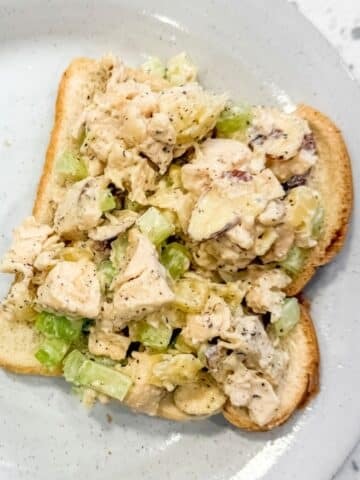 Hawaiian Chicken Salad
Hawaiian Chicken Salad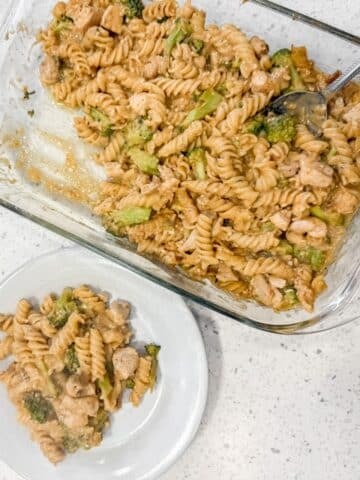 Chicken and Broccoli Pasta Bake
Chicken and Broccoli Pasta Bake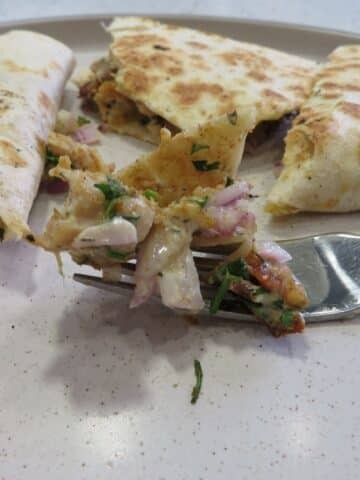 Chicken Bacon Ranch QuesadillaPairing with Broccoli Cashew Chicken Stir Fry
Chicken Bacon Ranch QuesadillaPairing with Broccoli Cashew Chicken Stir FryThese are my favorite dishes to serve with Cashew Chicken and broccoli:
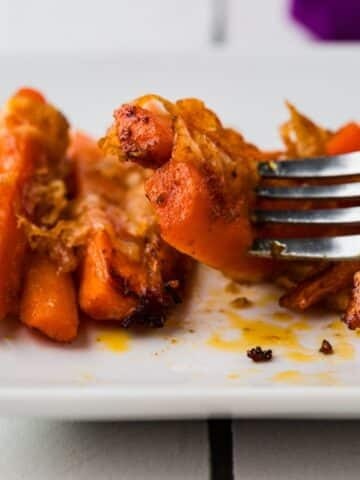 Parmesan Carrots
Parmesan Carrots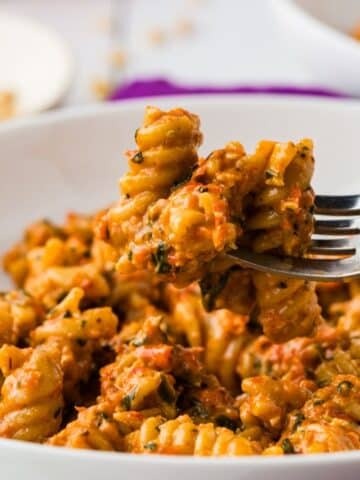 Roasted Red Pepper Pesto Pasta
Roasted Red Pepper Pesto Pasta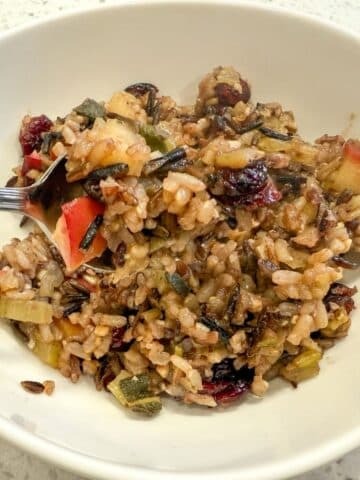 Wild Rice Stuffing
Wild Rice Stuffing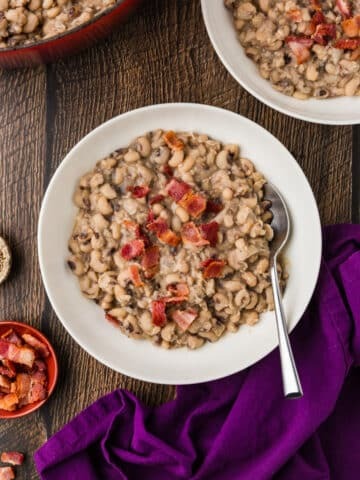 Frozen Blackeyed Peas Recipe
Frozen Blackeyed Peas RecipeIf you tried this Recipe or any other recipe on my website, please please leave a star rating and let me know how it goes in the comments below. I love hearing from you!
Recipe PrintBroccoli Cashew Chicken Stir Fry#wprm-recipe-user-rating-0 .wprm-rating-star.wprm-rating-star-full svg * { fill: #343434; }#wprm-recipe-user-rating-0 .wprm-rating-star.wprm-rating-star-33 svg * { fill: url(#wprm-recipe-user-rating-0-33); }#wprm-recipe-user-rating-0 .wprm-rating-star.wprm-rating-star-50 svg * { fill: url(#wprm-recipe-user-rating-0-50); }#wprm-recipe-user-rating-0 .wprm-rating-star.wprm-rating-star-66 svg * { fill: url(#wprm-recipe-user-rating-0-66); }linearGradient#wprm-recipe-user-rating-0-33 stop { stop-color: #343434; }linearGradient#wprm-recipe-user-rating-0-50 stop { stop-color: #343434; }linearGradient#wprm-recipe-user-rating-0-66 stop { stop-color: #343434; }#wprm-recipe-user-rating-0.wprm-user-rating-allowed.wprm-user-rating-not-voted:not(.wprm-user-rating-voting) svg * { fill-opacity: 0.3; }This Cashew Chicken and Broccoli Stir Fry is a flavorful, kidney-friendly dish that's low in sodium and packed with protein and vegetables. Quick to prepare and full of savory taste, itâs the perfect meal for those managing CKD while enjoying a delicious dinner.Course Entree, Main CourseCuisine American, ChineseDiet Diabetic, Low Calorie, Low Fat, Low SaltPrep Time 10 minutes minutesCook Time 20 minutes minutesTotal Time 30 minutes minutesServings 2Calories 535kcalAuthor Mathea Ford, RDN, LD, MBAEquipment1 SkilletIngredientsStir Fry Ingredients8 ounces boneless skinless chicken breasts cut into small pieces, 1" or smaller¼ cup flour2 tablespoon sesame oil2 cups broccoli florets cut into bite sized pieces½ cup sliced onion¼ cup no added salt cashews2 tablespoon minced garlic1 teaspoon ground gingerSauce Ingredients2 tablespoon low sodium soy sauce1 teaspoon balsamic vinegar1 tablespoon honey2 teaspoon rice vinegar1 teaspoon sesame oil1 tablespoon minced garlic2 tablespoon low sodium chicken broth1 teaspoon cornstarchGet ingredients with
PrintBroccoli Cashew Chicken Stir Fry#wprm-recipe-user-rating-0 .wprm-rating-star.wprm-rating-star-full svg * { fill: #343434; }#wprm-recipe-user-rating-0 .wprm-rating-star.wprm-rating-star-33 svg * { fill: url(#wprm-recipe-user-rating-0-33); }#wprm-recipe-user-rating-0 .wprm-rating-star.wprm-rating-star-50 svg * { fill: url(#wprm-recipe-user-rating-0-50); }#wprm-recipe-user-rating-0 .wprm-rating-star.wprm-rating-star-66 svg * { fill: url(#wprm-recipe-user-rating-0-66); }linearGradient#wprm-recipe-user-rating-0-33 stop { stop-color: #343434; }linearGradient#wprm-recipe-user-rating-0-50 stop { stop-color: #343434; }linearGradient#wprm-recipe-user-rating-0-66 stop { stop-color: #343434; }#wprm-recipe-user-rating-0.wprm-user-rating-allowed.wprm-user-rating-not-voted:not(.wprm-user-rating-voting) svg * { fill-opacity: 0.3; }This Cashew Chicken and Broccoli Stir Fry is a flavorful, kidney-friendly dish that's low in sodium and packed with protein and vegetables. Quick to prepare and full of savory taste, itâs the perfect meal for those managing CKD while enjoying a delicious dinner.Course Entree, Main CourseCuisine American, ChineseDiet Diabetic, Low Calorie, Low Fat, Low SaltPrep Time 10 minutes minutesCook Time 20 minutes minutesTotal Time 30 minutes minutesServings 2Calories 535kcalAuthor Mathea Ford, RDN, LD, MBAEquipment1 SkilletIngredientsStir Fry Ingredients8 ounces boneless skinless chicken breasts cut into small pieces, 1" or smaller¼ cup flour2 tablespoon sesame oil2 cups broccoli florets cut into bite sized pieces½ cup sliced onion¼ cup no added salt cashews2 tablespoon minced garlic1 teaspoon ground gingerSauce Ingredients2 tablespoon low sodium soy sauce1 teaspoon balsamic vinegar1 tablespoon honey2 teaspoon rice vinegar1 teaspoon sesame oil1 tablespoon minced garlic2 tablespoon low sodium chicken broth1 teaspoon cornstarchGet ingredients with  InstructionsPrepare the sauce - add all of the ingredients to a bowl, and mix well. Set aside.Dice the chicken into 1 in or smaller pieces. Dredge the chicken pieces in flour to coat them.Add 1 tablespoon sesame oil to large skillet over medium heat. Add the chicken and saute, tossing occasionally, for 5-7 minutes or until thoroughly cooked. Transfer to a plate and set aside.Add the remaining tablespoon of sesame oil to the pan over medium heat. Add the broccoli and onion and saute for 6-8 minutes.Add the cashews, garlic and ginger and saute for another 2-3 minutes or until the broccoli reaches your desired level of tenderness.Combine the sauce and cooked chicken with the broccoli mixture and toss together for 1 minute. Continue to cook until the sauce thickens and evenly coats the vegetables.Serve over noodles or rice as desired. Rice or noodles is not included in the nutritional information for this recipe.NutritionServing: 2g | Calories: 535kcal | Carbohydrates: 42g | Protein: 34g | Fat: 27g | Saturated Fat: 4g | Polyunsaturated Fat: 9g | Monounsaturated Fat: 11g | Trans Fat: 0.01g | Cholesterol: 73mg | Sodium: 749mg | Potassium: 1028mg | Fiber: 5g | Sugar: 13g | Vitamin A: 603IU | Vitamin C: 89mg | Vitamin D: 0.1µg | Calcium: 96mg | Iron: 4mg | Phosphorus: 475mgCheck Out Our Meal Plans For People With Chronic Kidney Disease (CKD)
InstructionsPrepare the sauce - add all of the ingredients to a bowl, and mix well. Set aside.Dice the chicken into 1 in or smaller pieces. Dredge the chicken pieces in flour to coat them.Add 1 tablespoon sesame oil to large skillet over medium heat. Add the chicken and saute, tossing occasionally, for 5-7 minutes or until thoroughly cooked. Transfer to a plate and set aside.Add the remaining tablespoon of sesame oil to the pan over medium heat. Add the broccoli and onion and saute for 6-8 minutes.Add the cashews, garlic and ginger and saute for another 2-3 minutes or until the broccoli reaches your desired level of tenderness.Combine the sauce and cooked chicken with the broccoli mixture and toss together for 1 minute. Continue to cook until the sauce thickens and evenly coats the vegetables.Serve over noodles or rice as desired. Rice or noodles is not included in the nutritional information for this recipe.NutritionServing: 2g | Calories: 535kcal | Carbohydrates: 42g | Protein: 34g | Fat: 27g | Saturated Fat: 4g | Polyunsaturated Fat: 9g | Monounsaturated Fat: 11g | Trans Fat: 0.01g | Cholesterol: 73mg | Sodium: 749mg | Potassium: 1028mg | Fiber: 5g | Sugar: 13g | Vitamin A: 603IU | Vitamin C: 89mg | Vitamin D: 0.1µg | Calcium: 96mg | Iron: 4mg | Phosphorus: 475mgCheck Out Our Meal Plans For People With Chronic Kidney Disease (CKD)The post Chicken and Broccoli with Cashews appeared first on Renal Diet HQ.
December 23, 2024
Parmesan Carrots
If you're looking for a delicious and kidney-friendly side dish, these Parmesan Carrots are the perfect choice. Packed with natural sweetness, savory flavors, and a touch of spice, this recipe is low in sodium and potassium, making it ideal for those managing Chronic Kidney Disease (CKD). Easy to prepare and full of heart-healthy ingredients, it's a flavorful addition to any meal!
As a Registered Dietitian specializing in Chronic Kidney Disease (CKD), I am passionate about helping individuals manage their health through personalized nutrition strategies. With years of experience working with CKD patients, I understand the importance of a well-balanced diet in supporting kidney function and overall well-being. I am dedicated to providing practical, evidence-based advice that empowers people to make informed choices about their health.
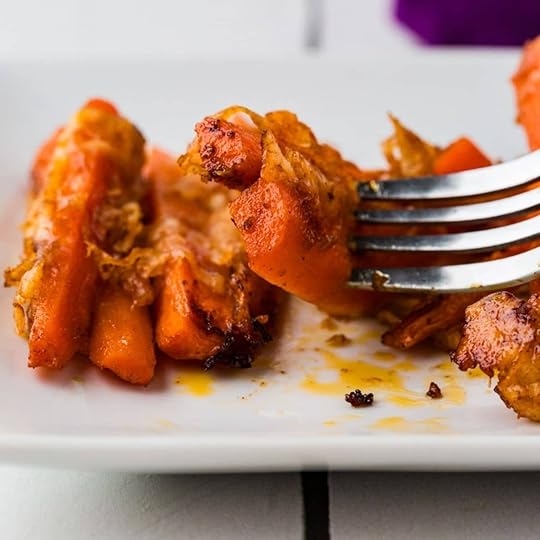
This Crispy Parmesan Carrot recipe is perfectly suited for a CKD-friendly diet, as it is low in sodium and potassium while providing heart-healthy fats from olive oil. The use of flavorful herbs and spices enhances taste without relying on high-sodium seasonings, making it a nutritious and delicious side dish for those managing Chronic Kidney Disease.
Imagine this paired with other kidney friendly side dishes, like wild rice stuffing or Italian peas. You can make a yummy meal with these carrots and a nice CKD Chicken recipe as well.
[feast_advanced_jump_to]Ingredients for Roasted Carrots with ParmesanThis simple yet flavorful parmesan carrots recipe uses a handful of wholesome ingredients, including fresh carrots, heart-healthy olive oil, and a blend of aromatic spices. Together, they create a delicious dish that's both satisfying and perfect for a CKD-friendly diet.
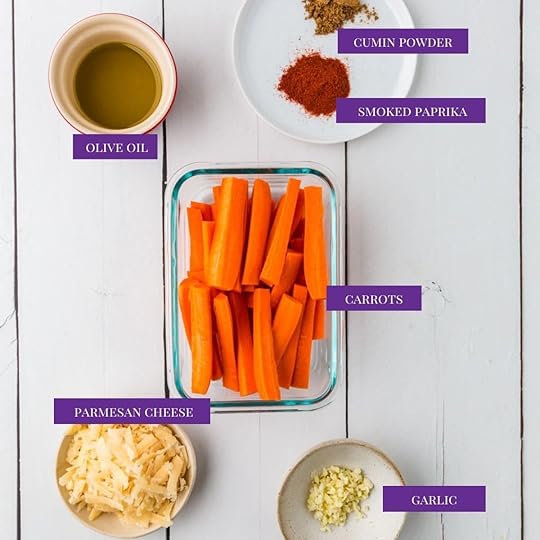 Carrot sticks â A low-potassium vegetable that adds natural sweetness and a satisfying crunch, making it ideal for kidney-friendly recipes.Grated Parmesan cheese â A flavorful, low-moisture cheese that can be used sparingly to add richness without significantly increasing sodium levels.Olive oil â A heart-healthy fat that enhances the flavor of the dish and supports overall cardiovascular health, crucial for those with CKD.Minced garlic â A natural flavor enhancer that helps reduce the need for added salt while offering potential anti-inflammatory benefits.Smoked paprika â A spice that adds depth and smokiness to the dish without relying on high-sodium seasonings.Cumin powder â A warm, earthy spice that complements the carrots while providing a subtle boost in flavor and nutrition.
Carrot sticks â A low-potassium vegetable that adds natural sweetness and a satisfying crunch, making it ideal for kidney-friendly recipes.Grated Parmesan cheese â A flavorful, low-moisture cheese that can be used sparingly to add richness without significantly increasing sodium levels.Olive oil â A heart-healthy fat that enhances the flavor of the dish and supports overall cardiovascular health, crucial for those with CKD.Minced garlic â A natural flavor enhancer that helps reduce the need for added salt while offering potential anti-inflammatory benefits.Smoked paprika â A spice that adds depth and smokiness to the dish without relying on high-sodium seasonings.Cumin powder â A warm, earthy spice that complements the carrots while providing a subtle boost in flavor and nutrition.See recipe card for quantities.
How To Make Roasted Carrots with ParmesanNow that you have your ingredients ready, let's move on to preparing these tasty Parmesan Carrots. Follow these simple steps to create a flavorful, kidney-friendly side dish in no time!
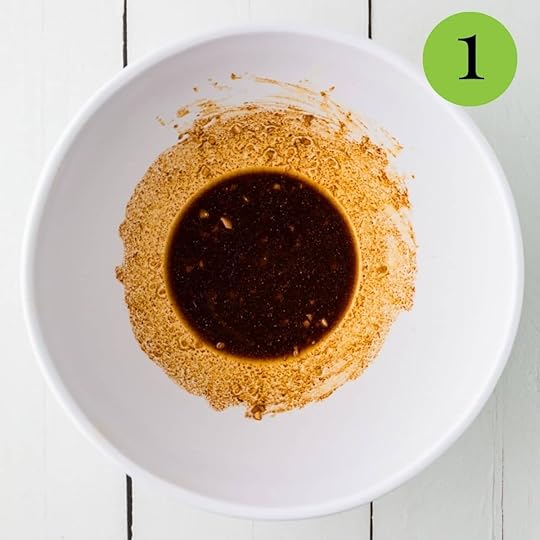
1. Preheat oven to 350'F. Prepare carrots by peeling them and slicing them into sticks. You can also make carrot coins if you like instead of sticks.

2. In a large bowl, mix together the olive oil, garlic, paprika and cumin powder. Mix together to make the sauce/marinade for the carrots.

3. Add the carrots to the mixture and mix to combine to ensure all carrots are coated.

4. Line a cookie sheet with parchment paper. Spray with non stick pan spray. Place ½ of the parmesan cheese in the middle in a small layer large enough to lay the carrots on side by side.

5. Lay the carrots on the cookie sheet on top of the parmesan. Set them next to each other so they are touching. Add remaining cheese and marinade on top of the carrots.
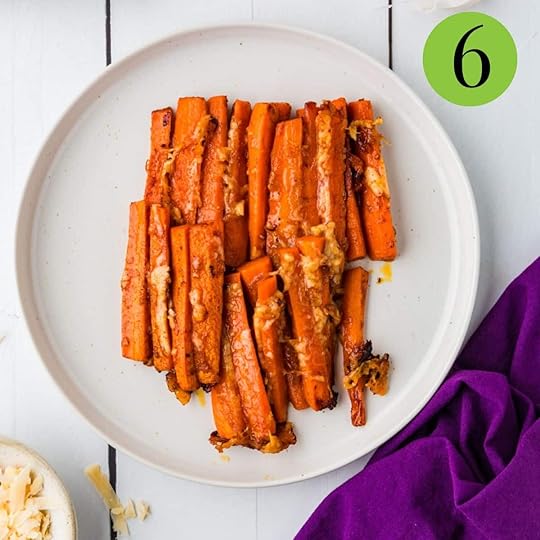
6. Roast for 20-25 minutes or until carrots are fully cooked.
7. Remove from oven and flip over immediately to let the parmesan melt onto the carrots. Enjoy.
Hint: Roasting Tip: If you like your carrots extra crispy, increase the roasting time by a few minutes, but keep an eye on them to avoid burning.
SubstitutionsIf you need to adjust the recipe to fit specific dietary preferences or restrictions, here are some substitutions that keep it kidney-friendly:
Garlic Substitute: For those who prefer a milder flavor, use garlic powder in place of minced garlic.Olive Oil Substitute: Use avocado oil instead of olive oil for a slightly richer taste with heart-healthy fats.Parmesan Substitute: Opt for a lower-sodium cheese like part-skim mozzarella if you need to reduce the sodium content further.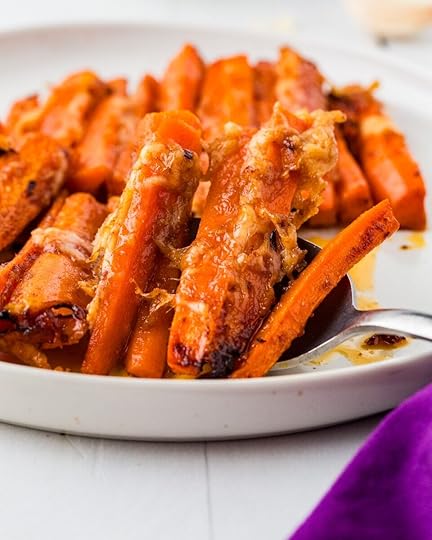 Variations on Crispy Parmesan Carrots
Variations on Crispy Parmesan CarrotsThis recipe is versatile and can be easily adapted to suit different flavor profiles while maintaining its kidney-friendly benefits. Here are a few variations to try:
Vegetarian Version: Replace the Parmesan with a plant-based cheese or nutritional yeast for a dairy-free option thatâs still flavorful.Herb-Infused: Swap out the smoked paprika and cumin for thyme and rosemary for a fragrant, earthy alternative.Sweet & Savory: Add a drizzle of honey or maple syrup over the roasted carrots for a touch of sweetness that complements the savory Parmesan.StorageTo store your Parmesan Carrots and keep them fresh for future meals, follow these tips:
Reheating: To keep the carrots crisp, reheat them in the oven at 350°F for 5-10 minutes, or until heated through. Avoid microwaving, as this may cause the carrots to become soggy.Refrigeration: Allow the roasted carrots to cool to room temperature before transferring them to an airtight container. Store in the refrigerator for up to 3-4 days.Freezing: For longer storage, place the cooled carrots on a baking sheet in a single layer to freeze. Once frozen, transfer them to a freezer-safe container or bag and store for up to 2-3 months. Reheat in the oven to maintain their crispiness.Top TipCustomize the Spice: If you like a bit more heat, add a pinch of cayenne pepper or chili flakes to the spice mix for an extra kick.FAQCan I use baby carrots instead of regular carrots?Yes, baby carrots work just as well in this recipe. Simply cut them in half or quarters lengthwise to ensure they cook evenly and can absorb the seasoning.
Are there any low-sodium alternatives to Parmesan cheese?Yes, you can use a lower-sodium cheese like part-skim mozzarella or nutritional yeast for a dairy-free option. These alternatives will still add flavor without the added sodium.
How can I make this recipe spicier?To give the dish a bit of heat, try adding a pinch of cayenne pepper or red pepper flakes along with the smoked paprika and cumin. Adjust the amount to your preferred spice level.
Related Side Dish RecipesLooking for other recipes like this? Try these:
 Parmesan Carrots
Parmesan Carrots Roasted Red Pepper Pesto Pasta
Roasted Red Pepper Pesto Pasta Wild Rice Stuffing
Wild Rice Stuffing Frozen Blackeyed Peas RecipePairing with Roasted Parmesan Carrots
Frozen Blackeyed Peas RecipePairing with Roasted Parmesan CarrotsKidney friendly chicken entrees work perfectly with these carrots roasted in the oven:
 Hawaiian Chicken Salad
Hawaiian Chicken Salad Chicken and Broccoli Pasta Bake
Chicken and Broccoli Pasta Bake Chicken Bacon Ranch Quesadilla
Chicken Bacon Ranch Quesadilla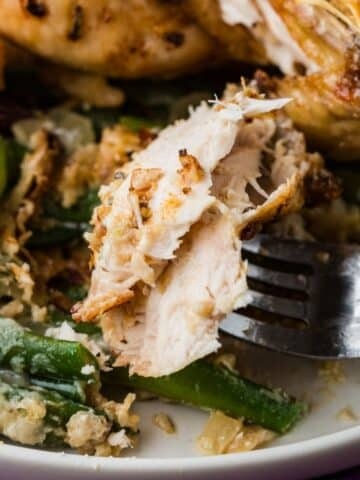 Roasted Cornish Hens
Roasted Cornish HensIf you tried this Recipe or any other recipe on my website, please please leave a star rating and let me know how it goes in the comments below. I love hearing from you!
Recipe PrintParmesan Carrots#wprm-recipe-user-rating-0 .wprm-rating-star.wprm-rating-star-full svg * { fill: #343434; }#wprm-recipe-user-rating-0 .wprm-rating-star.wprm-rating-star-33 svg * { fill: url(#wprm-recipe-user-rating-0-33); }#wprm-recipe-user-rating-0 .wprm-rating-star.wprm-rating-star-50 svg * { fill: url(#wprm-recipe-user-rating-0-50); }#wprm-recipe-user-rating-0 .wprm-rating-star.wprm-rating-star-66 svg * { fill: url(#wprm-recipe-user-rating-0-66); }linearGradient#wprm-recipe-user-rating-0-33 stop { stop-color: #343434; }linearGradient#wprm-recipe-user-rating-0-50 stop { stop-color: #343434; }linearGradient#wprm-recipe-user-rating-0-66 stop { stop-color: #343434; }#wprm-recipe-user-rating-0.wprm-user-rating-allowed.wprm-user-rating-not-voted:not(.wprm-user-rating-voting) svg * { fill-opacity: 0.3; }These Parmesan Carrots are a tasty and kidney-friendly side dish, packed with flavor and perfect for those managing CKD. With simple ingredients and easy preparation, they make a delicious addition to any meal!Course Appetizer, Side Dish, SnackCuisine AmericanDiet Diabetic, Gluten Free, Low Fat, Low Salt, VegetarianCook Time 25 minutes minutesTotal Time 25 minutes minutesServings 2Calories 209kcalAuthor Mathea Ford, RDN, LD, MBAIngredients1 cup carrot sticks about 3 medium carrots¼ cup grated parmesan cheese2 tablespoon olive oil1 tablespoon minced garlic1 teaspoon smoked paprika½ teaspoon cumin powderGet ingredients with
PrintParmesan Carrots#wprm-recipe-user-rating-0 .wprm-rating-star.wprm-rating-star-full svg * { fill: #343434; }#wprm-recipe-user-rating-0 .wprm-rating-star.wprm-rating-star-33 svg * { fill: url(#wprm-recipe-user-rating-0-33); }#wprm-recipe-user-rating-0 .wprm-rating-star.wprm-rating-star-50 svg * { fill: url(#wprm-recipe-user-rating-0-50); }#wprm-recipe-user-rating-0 .wprm-rating-star.wprm-rating-star-66 svg * { fill: url(#wprm-recipe-user-rating-0-66); }linearGradient#wprm-recipe-user-rating-0-33 stop { stop-color: #343434; }linearGradient#wprm-recipe-user-rating-0-50 stop { stop-color: #343434; }linearGradient#wprm-recipe-user-rating-0-66 stop { stop-color: #343434; }#wprm-recipe-user-rating-0.wprm-user-rating-allowed.wprm-user-rating-not-voted:not(.wprm-user-rating-voting) svg * { fill-opacity: 0.3; }These Parmesan Carrots are a tasty and kidney-friendly side dish, packed with flavor and perfect for those managing CKD. With simple ingredients and easy preparation, they make a delicious addition to any meal!Course Appetizer, Side Dish, SnackCuisine AmericanDiet Diabetic, Gluten Free, Low Fat, Low Salt, VegetarianCook Time 25 minutes minutesTotal Time 25 minutes minutesServings 2Calories 209kcalAuthor Mathea Ford, RDN, LD, MBAIngredients1 cup carrot sticks about 3 medium carrots¼ cup grated parmesan cheese2 tablespoon olive oil1 tablespoon minced garlic1 teaspoon smoked paprika½ teaspoon cumin powderGet ingredients with  InstructionsPreheat oven to 350'F. Prepare carrots by peeling them and slicing them into sticks. You can also make carrot coins if you like instead of sticks.In a large bowl, mix together the olive oil, garlic, paprika and cumin powder. Mix together to make the sauce/marinade for the carrots.Add the carrots to the mixture and mix to combine to ensure all carrots are coated.Line a cookie sheet with parchment paper. Spray with non stick pan spray. Place ½ of the parmesan cheese in the middle in a small layer large enough to lay the carrots on side by side.Lay the carrots on the cookie sheet on top of the parmesan. Set them next to each other so they are touching. Add remaining cheese and marinade on top of the carrots.Roast for 20-25 minutes or until carrots are fully cooked.Remove from oven and flip over immediately to let the parmesan melt onto the carrots. Enjoy.NutritionCalories: 209kcal | Carbohydrates: 9g | Protein: 5g | Fat: 18g | Saturated Fat: 4g | Polyunsaturated Fat: 2g | Monounsaturated Fat: 11g | Cholesterol: 11mg | Sodium: 271mg | Potassium: 223mg | Fiber: 2g | Sugar: 3g | Vitamin A: 9433IU | Vitamin C: 3mg | Vitamin D: 0.1µg | Calcium: 145mg | Iron: 1mg | Phosphorus: 109mgCheck Out Our Meal Plans For People With Chronic Kidney Disease (CKD)
InstructionsPreheat oven to 350'F. Prepare carrots by peeling them and slicing them into sticks. You can also make carrot coins if you like instead of sticks.In a large bowl, mix together the olive oil, garlic, paprika and cumin powder. Mix together to make the sauce/marinade for the carrots.Add the carrots to the mixture and mix to combine to ensure all carrots are coated.Line a cookie sheet with parchment paper. Spray with non stick pan spray. Place ½ of the parmesan cheese in the middle in a small layer large enough to lay the carrots on side by side.Lay the carrots on the cookie sheet on top of the parmesan. Set them next to each other so they are touching. Add remaining cheese and marinade on top of the carrots.Roast for 20-25 minutes or until carrots are fully cooked.Remove from oven and flip over immediately to let the parmesan melt onto the carrots. Enjoy.NutritionCalories: 209kcal | Carbohydrates: 9g | Protein: 5g | Fat: 18g | Saturated Fat: 4g | Polyunsaturated Fat: 2g | Monounsaturated Fat: 11g | Cholesterol: 11mg | Sodium: 271mg | Potassium: 223mg | Fiber: 2g | Sugar: 3g | Vitamin A: 9433IU | Vitamin C: 3mg | Vitamin D: 0.1µg | Calcium: 145mg | Iron: 1mg | Phosphorus: 109mgCheck Out Our Meal Plans For People With Chronic Kidney Disease (CKD)The post Parmesan Carrots appeared first on Renal Diet HQ.
December 20, 2024
Top Tips for Finding LowSodium Canned Foods on a CKD Diet-Podcast

Living with Chronic Kidney Disease (CKD) often means making significant changes to your diet, particularly when it comes to sodium. With the abundance of processed and packaged foods available, finding low-sodium options can feel overwhelming. However, CKD doesnât mean sacrificing flavor or satisfaction. By carefully selecting low-sodium canned foods, you can enjoy nutritious and delicious meals while managing your kidney health and saving time for other priorities.
For More Recipes and Ideas --->> Get Your Free Meals and Recipes That Are Perfect for Pre-Dialysis Diets, Pre-Dialysis with Diabetes, or Dialysis Diets.
Meet the ExpertHello! Iâm Mathea Ford, a registered dietitian nutritionist specializing in chronic kidney disease and owner of RenalDietHQ.com. For years, Iâve helped individuals with CKD improve their health through simple, yet flavorful dietary changes. Together, we can transform your eating habits, enhance your overall well-being, and ensure every meal is enjoyable. Say goodbye to bland, repetitive meals and hello to a healthier, more vibrant life.
Why Sodium Matters in a CKD DietSodium plays a crucial role in CKD management. High sodium levels can increase blood pressure and strain your kidneys, which is why doctors often recommend lowering sodium intake to around 2,300 mg per day. Reducing sodium not only eases kidney workload but also brings a host of benefits, including:
Lower Blood Pressure: Improved circulation and reduced strain on the heart and kidneys.Better Kidney Health: Less stress on the kidneys leads to improved functionality.Reduced Risk of Heart Disease and Stroke: Lower sodium levels contribute to healthier blood vessels.Improved Mental Clarity and Energy: Consuming less salt can help decrease fatigue and enhance alertness.Emotionally, sticking to a low-sodium diet can boost self-esteem and reduce anxiety about food choices, giving you a sense of control and satisfaction.
Tips for Grocery Shopping for Low-Sodium FoodsNavigating the grocery store with a low-sodium diet in mind doesnât have to be stressful. Here are some tips to help you make the best choices:
1. Read Nutrition LabelsAlways check the sodium content on nutrition labels. A good rule of thumb is to aim for foods with 140 mg or less of sodium per serving. Be cautious of hidden sodium in preservatives, condiments, and flavorings.
2. Create a Low-Sodium Shopping ListPrepare a list of kidney-friendly items, such as:
Fresh fruits and vegetables.Whole grains like oats and brown rice.Dried beans, lentils, and legumes.Unsalted nuts and seeds.Meat alternatives like tofu and tempeh.3. Compare ProductsLook at the nutrition panels of different brands to identify those with the lowest sodium content. Be mindful of potassium levels, too, to ensure compatibility with your CKD diet.
Choosing Low-Sodium Canned FoodsCanned foods can be a lifesaver for quick and easy meal prep, but they often come with high sodium content. Hereâs how to make smarter choices:
Vegetables: Opt for canned vegetables labeled âno added saltâ or âlow sodium.â These still provide essential nutrients while being easier on your kidneys.Legumes and Beans: Low-sodium canned beans and lentils are versatile and packed with fiber, making them great additions to meals.Proteins: Choose low-sodium canned options like salmon, tuna, and chicken. Monitor portion sizes to avoid excess protein intake.Reducing Sodium in Canned FoodsEven if you canât find low-sodium options, you can reduce the sodium content of regular canned foods by rinsing and draining them. This simple step can remove up to 40% of the sodium, making these items more suitable for your diet. Pair this with salt-free seasonings and steer clear of high-sodium ingredients like MSG to further manage your sodium intake.
Portion Control Tips for a CKD DietEven with low-sodium foods, portion control is essential for maintaining your daily sodium limits. Here are some practical tips:
Use measuring cups or spoons to ensure accurate portion sizes.Divide large servings into smaller portions before eating.Avoid processed convenience foods, which often contain hidden sodium.By incorporating portion control into your routine, you can stay within your sodium limits while enjoying flavorful meals.
Enhancing Flavor Without SaltWho says low-sodium meals have to be bland? Avoid salt substitutes containing potassium chloride, as they can raise potassium levels. Instead, enhance your dishes with fresh or dried herbs and spices. Try salt-free seasoning blends like Italian seasoning or Mrs. Dash for easy and flavorful options. Experimenting with new herbs and spices can transform your meals into exciting culinary creations.
Making Low-Sodium Eating EnjoyableEating healthy doesnât have to mean sacrificing flavor or fun. With careful shopping and planning, you can create meals that are both delicious and nutritious. Remember to:
Look for âlow sodiumâ or âno added saltâ labels.Incorporate fresh or frozen ingredients.Get creative with herbs, spices, and salt-free seasoning blends.Finding low-sodium canned foods for a CKD diet may seem challenging at first, but with the right strategies, itâs entirely achievable. By prioritizing nutrition, reading labels, and experimenting with flavors, you can enjoy satisfying meals while supporting your kidney health. For more tips, recipes, and resources, visit RenalDietHQ.com today and take the first step towards a healthier lifestyle!
Learn more about Kidney-Friendly Breakfast Ideas Perfect for Dialysis Patients-Podcast
The post Top Tips for Finding LowSodium Canned Foods on a CKD Diet-Podcast appeared first on Renal Diet HQ.
December 19, 2024
Baked Pears
If you're looking for a delicious and easy dessert that's both satisfying and kidney-friendly, these Cinnamon Baked Pears are the perfect choice. With their natural sweetness, heart-healthy walnuts, and minimal potassium, this recipe offers a tasty treat that fits seamlessly into a CKD-friendly diet, allowing you to indulge without compromise. And just 5 ingredients!
As a Registered Dietitian specializing in chronic kidney disease (CKD), I have extensive experience helping individuals manage their health through nutrition. With a deep understanding of the dietary needs for CKD, I focus on providing practical, kidney-friendly recipes that support overall health and well-being. My approach is grounded in evidence-based practices, ensuring that each recommendation is tailored to the unique needs of those managing CKD.
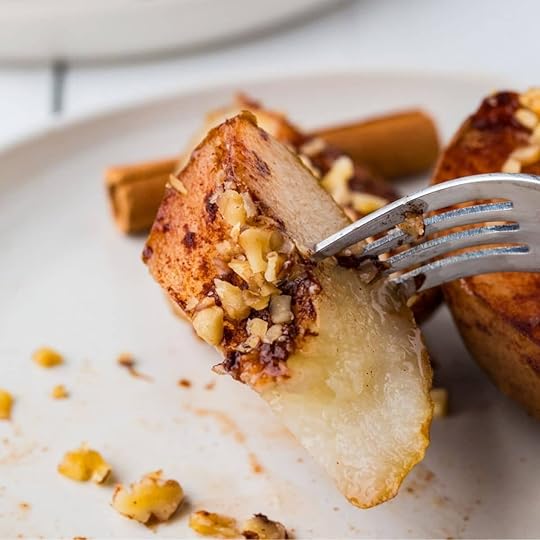
These Cinnamon Baked Pears are an excellent choice for a CKD-friendly diet, as they are low in potassium and sodium while providing fiber and healthy fats. The use of natural sweeteners like maple syrup and lemon juice ensures a flavorful dessert without compromising kidney health, making it a safe and delicious option for those managing CKD.
Eat these as a dessert with your roasted pepper pesto pasta entree or some Hawaiian chicken salad that is as easy to make as these pears are! And if you are craving black-eyed peas with your diet, try it with those.
[feast_advanced_jump_to]Ingredients for Pear Baked DessertThis simple yet delicious cooked pears recipe uses just a handful of wholesome ingredients like ripe pears, ground cinnamon, and maple syrup, making it both flavorful and kidney-friendly. With the addition of lemon juice, vanilla extract, and walnuts, these ingredients come together to create a warm, satisfying dessert thatâs perfect for anyone following a CKD-friendly diet.
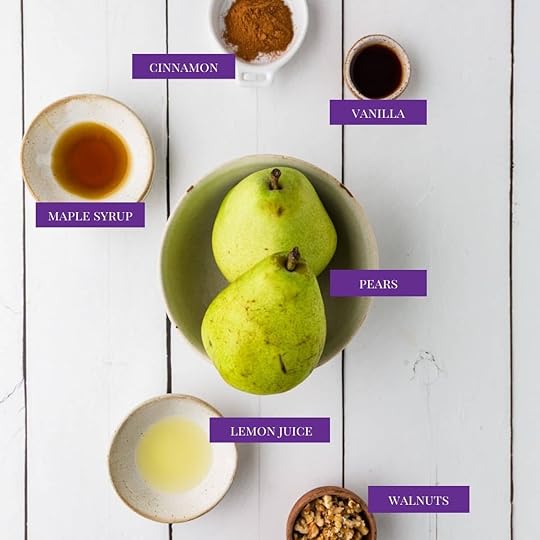 Pears: Pears are low in potassium and high in fiber, making them a great fruit choice for those managing CKD.Ground Cinnamon: Cinnamon adds natural sweetness and flavor without the need for added sugar, and it has anti-inflammatory properties.Maple Syrup: Maple syrup offers a natural sweetener option with minimal sodium, making it a kidney-friendly choice when used in moderation.Lemon Juice: Lemon juice provides a fresh, tangy flavor with a low potassium content, helping to enhance taste without adding salt.Vanilla Extract: Vanilla extract offers a rich, aromatic flavor with a minimal effect on sodium or potassium levels, perfect for enhancing sweetness naturally.Chopped Walnuts: Walnuts provide heart-healthy fats and protein, offering essential nutrients that support kidney health without overloading on sodium or potassium
Pears: Pears are low in potassium and high in fiber, making them a great fruit choice for those managing CKD.Ground Cinnamon: Cinnamon adds natural sweetness and flavor without the need for added sugar, and it has anti-inflammatory properties.Maple Syrup: Maple syrup offers a natural sweetener option with minimal sodium, making it a kidney-friendly choice when used in moderation.Lemon Juice: Lemon juice provides a fresh, tangy flavor with a low potassium content, helping to enhance taste without adding salt.Vanilla Extract: Vanilla extract offers a rich, aromatic flavor with a minimal effect on sodium or potassium levels, perfect for enhancing sweetness naturally.Chopped Walnuts: Walnuts provide heart-healthy fats and protein, offering essential nutrients that support kidney health without overloading on sodium or potassiumSee recipe card for quantities.
How To Make Baked Pears with CinnamonNow that you have all the ingredients ready, itâs time to turn them into a delicious, kidney-friendly dessert. Follow these simple steps to prepare warm, fragrant Cinnamon Baked Pears that are sure to delight your taste buds.
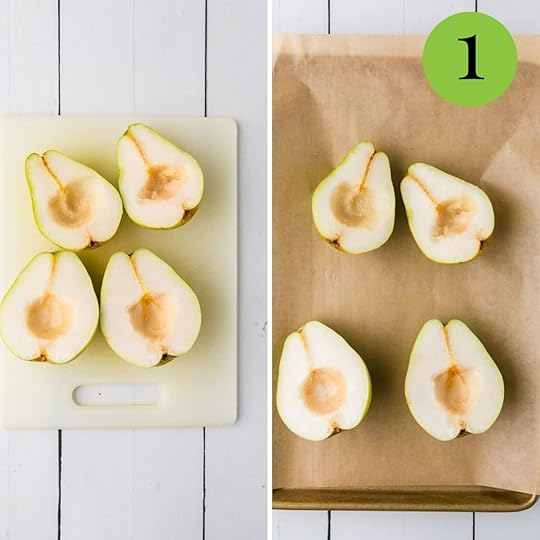 Preheat oven to 350'F, and prepare a cookie sheet by lining it with parchment paper and spraying with non stick spray.Cut your pears in half from top to bottom and remove the core using a melon baller or spoon. Pull off the stem.
Preheat oven to 350'F, and prepare a cookie sheet by lining it with parchment paper and spraying with non stick spray.Cut your pears in half from top to bottom and remove the core using a melon baller or spoon. Pull off the stem.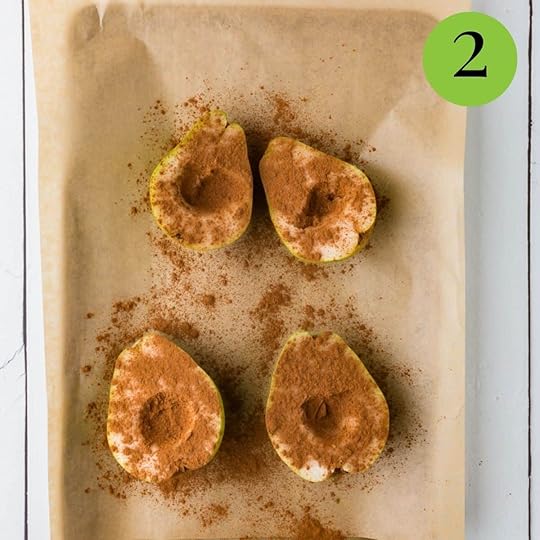
3. Place them skin side down on top of the lined cookie sheet.
4. Sprinkle the pears with cinnamon evenly.

5. Mix the maple syrup, lemon juice and vanilla and drizzle over the pears evenly.

6. Flip the pears over, place a tent of aluminum foil over them loosely, and bake for 30-35 minutes until the pears are fork tender.
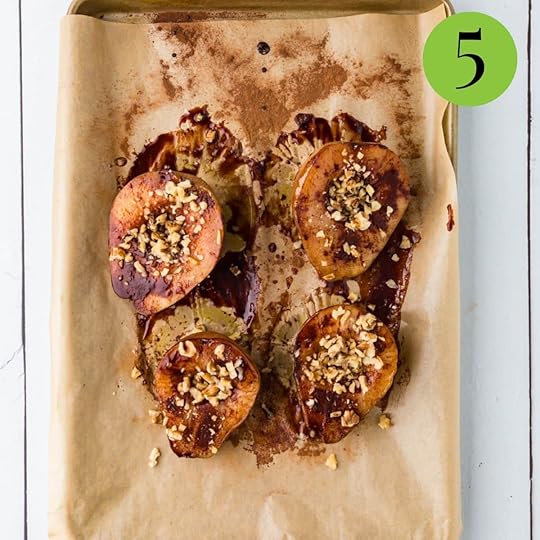
7. Remove the pears from the oven, flip them over and sprinkle with walnuts. Bake for 5 more minutes.
8. Serve warm.
Hint: Opt for firm but ripe pears to ensure they hold their shape during baking while achieving a tender texture.
How To Make Air Fryer Baked PearsThese are the changes to the recipe that I suggest to cook the recipe for pear baked dessert in the air fryer.
Preheat the air fryer to 350'F - if you don't have the preheat setting, allow it to run empty for about 3 minutes at 350'FFollow the other directions up to putting the pears in the ovenLightly spray or brush the air fryer basket with non stick spray (or line with perforated parchment paper designed for air fryers)Place the pears cut side down in the basket, and air fry for 8-10 minutes.Flip the pears, add the walnuts and continue air frying for 5-7 more minutes. Watch that the walnuts don't burnCheck for doneness early, as air fryers cook faster than traditional ovens.Clean-Up Tip: If youâre worried about drips or sticky residue, place a small heat-proof dish or piece of parchment paper under the pears to catch any syrup.Substitutions for Baked PearsIf you need to make adjustments to better suit your dietary needs or ingredient availability, here are three kidney-friendly substitutions:
Lemon Juice Substitute: Try apple cider vinegar for a similar tangy effect if fresh lemons are unavailable.Sweetener Swap: Replace maple syrup with honey or agave nectar for a slightly different but equally natural sweet taste.Vanilla Extract Alternative: Use almond extract sparingly for a unique flavor twist thatâs still kidney-friendly.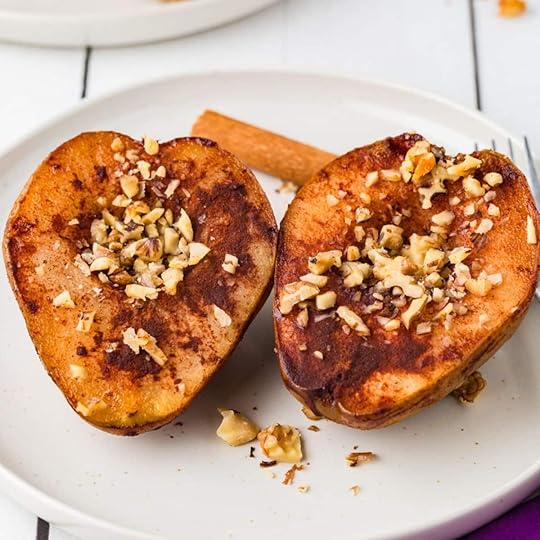 Variations on Baked Cinnamon Pears
Variations on Baked Cinnamon PearsThis recipe is versatile, allowing you to tweak it while still keeping it kidney-friendly. Here are three variations to suit different preferences:
Nut-Free Option: Substitute walnuts with a sprinkle of rolled oats for a nut-free, fiber-rich topping.Spiced Delight: Add a pinch of nutmeg or cardamom alongside cinnamon for a richer flavor profile.Fruit Fusion: Pair the pears with fresh cranberries or diced apples for added natural sweetness and texture.Top TipToast the walnuts briefly before sprinkling them on the pears for an extra crunch and enhanced flavor.FAQCan I use a different type of fruit instead of pears?Yes, you can substitute pears with apples, peaches, or nectarines, but ensure the chosen fruit aligns with your CKD dietary needs and is low in potassium.
What if I donât have maple syrup?You can replace maple syrup with honey or agave nectar for a similar natural sweetness. Choose options without added sugars to keep it kidney-friendly.
Are there any nut-free alternatives to walnuts?Yes, you can use rolled oats or sunflower seeds for a nut-free topping that still provides texture and flavor.
How do I know when the pears are done baking?The pears are ready when they are fork-tender but not mushy. This typically takes 30-35 minutes, with an additional 5 minutes after adding the walnuts.
Related Dessert RecipesLooking for other recipes like this? Try these:
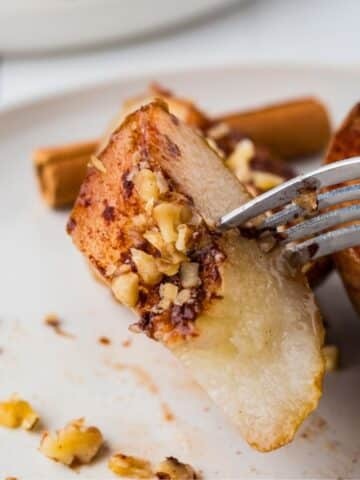 Baked Pears
Baked Pears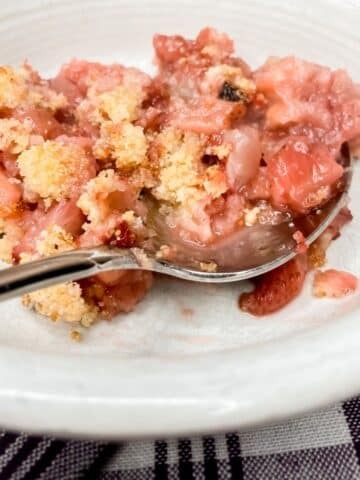 Healthy Strawberry Cobbler
Healthy Strawberry Cobbler Dairy Free Creme Brulee
Dairy Free Creme Brulee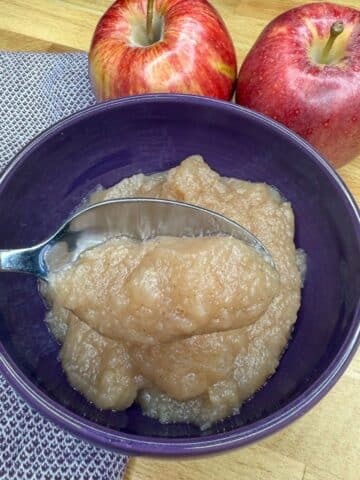 Sugar Free ApplesaucePairing with Baked Pears
Sugar Free ApplesaucePairing with Baked PearsThese are my favorite dishes to serve with Cinnamon Baked Pears:
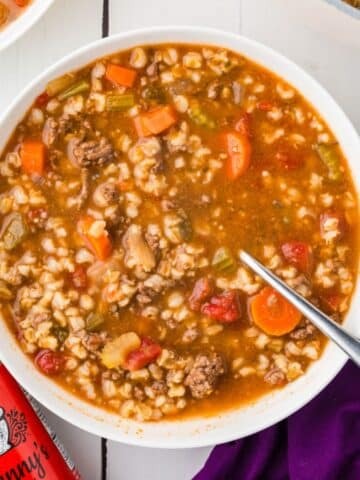 Low Sodium Beef Barley Soup
Low Sodium Beef Barley Soup Holiday Meal for CKD
Holiday Meal for CKD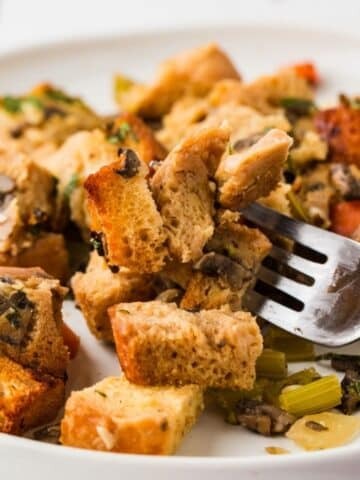 Vegetable Stuffing
Vegetable Stuffing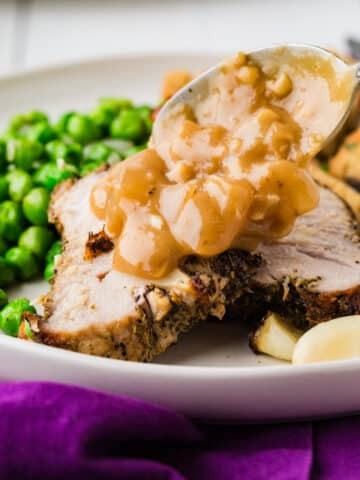 Roast Pork Ribeye
Roast Pork RibeyeIf you tried this Recipe or any other recipe on my website, please please leave a star rating and let me know how it goes in the comments below. I love hearing from you!
Recipe PrintCinnamon Baked Pears Recipe#wprm-recipe-user-rating-1 .wprm-rating-star.wprm-rating-star-full svg * { fill: #343434; }#wprm-recipe-user-rating-1 .wprm-rating-star.wprm-rating-star-33 svg * { fill: url(#wprm-recipe-user-rating-1-33); }#wprm-recipe-user-rating-1 .wprm-rating-star.wprm-rating-star-50 svg * { fill: url(#wprm-recipe-user-rating-1-50); }#wprm-recipe-user-rating-1 .wprm-rating-star.wprm-rating-star-66 svg * { fill: url(#wprm-recipe-user-rating-1-66); }linearGradient#wprm-recipe-user-rating-1-33 stop { stop-color: #343434; }linearGradient#wprm-recipe-user-rating-1-50 stop { stop-color: #343434; }linearGradient#wprm-recipe-user-rating-1-66 stop { stop-color: #343434; }#wprm-recipe-user-rating-1.wprm-user-rating-allowed.wprm-user-rating-not-voted:not(.wprm-user-rating-voting) svg * { fill-opacity: 0.3; }These Cinnamon Baked Pears are a warm and flavorful dessert, perfect for those following a CKD-friendly diet. With natural sweetness, heart-healthy walnuts, and a hint of spice, this easy recipe is both nutritious and delicious!Course Dessert, SnackCuisine AmericanDiet Low Fat, Low Lactose, Low Salt, Vegan, VegetarianPrep Time 10 minutes minutesCook Time 40 minutes minutesTotal Time 40 minutes minutesServings 2Calories 171kcalAuthor Mathea Ford, RDN, LD, MBAEquipment1 Chef's Knife1 Large BowlIngredients2 ripe pears1 teaspoon ground cinnamon1 tablespoon maple syrup1 tablespoon lemon juice1 teaspoon vanilla extract1 tablespoon chopped walnutsGet ingredients with
PrintCinnamon Baked Pears Recipe#wprm-recipe-user-rating-1 .wprm-rating-star.wprm-rating-star-full svg * { fill: #343434; }#wprm-recipe-user-rating-1 .wprm-rating-star.wprm-rating-star-33 svg * { fill: url(#wprm-recipe-user-rating-1-33); }#wprm-recipe-user-rating-1 .wprm-rating-star.wprm-rating-star-50 svg * { fill: url(#wprm-recipe-user-rating-1-50); }#wprm-recipe-user-rating-1 .wprm-rating-star.wprm-rating-star-66 svg * { fill: url(#wprm-recipe-user-rating-1-66); }linearGradient#wprm-recipe-user-rating-1-33 stop { stop-color: #343434; }linearGradient#wprm-recipe-user-rating-1-50 stop { stop-color: #343434; }linearGradient#wprm-recipe-user-rating-1-66 stop { stop-color: #343434; }#wprm-recipe-user-rating-1.wprm-user-rating-allowed.wprm-user-rating-not-voted:not(.wprm-user-rating-voting) svg * { fill-opacity: 0.3; }These Cinnamon Baked Pears are a warm and flavorful dessert, perfect for those following a CKD-friendly diet. With natural sweetness, heart-healthy walnuts, and a hint of spice, this easy recipe is both nutritious and delicious!Course Dessert, SnackCuisine AmericanDiet Low Fat, Low Lactose, Low Salt, Vegan, VegetarianPrep Time 10 minutes minutesCook Time 40 minutes minutesTotal Time 40 minutes minutesServings 2Calories 171kcalAuthor Mathea Ford, RDN, LD, MBAEquipment1 Chef's Knife1 Large BowlIngredients2 ripe pears1 teaspoon ground cinnamon1 tablespoon maple syrup1 tablespoon lemon juice1 teaspoon vanilla extract1 tablespoon chopped walnutsGet ingredients with  InstructionsPreheat oven to 350'F, and prepare a cookie sheet by lining it with parchment paper and spraying with non stick spray.Cut your pears in half from top to bottom and remove the core using a melon baller or spoon. Pull off the stem.Place them skin side down on top of the lined cookie sheet.Sprinkle the pears with cinnamon evenly.Mix the maple syrup, lemon juice and vanilla and drizzle over the pears evenly.Flip the pears over, place a tent of aluminum foil over them loosely, and bake for 30-35 minutes until the pears are fork tender.Remove the pears from the oven, flip them over and sprinkle with walnuts. Bake for 5 more minutes.Serve warm.NutritionCalories: 171kcal | Carbohydrates: 36g | Protein: 1g | Fat: 4g | Saturated Fat: 0.4g | Polyunsaturated Fat: 3g | Monounsaturated Fat: 1g | Sodium: 3mg | Potassium: 266mg | Fiber: 6g | Sugar: 24g | Vitamin A: 49IU | Vitamin C: 11mg | Calcium: 43mg | Iron: 1mg | Phosphorus: 40mgCheck Out Our Meal Plans For People With Chronic Kidney Disease (CKD)
InstructionsPreheat oven to 350'F, and prepare a cookie sheet by lining it with parchment paper and spraying with non stick spray.Cut your pears in half from top to bottom and remove the core using a melon baller or spoon. Pull off the stem.Place them skin side down on top of the lined cookie sheet.Sprinkle the pears with cinnamon evenly.Mix the maple syrup, lemon juice and vanilla and drizzle over the pears evenly.Flip the pears over, place a tent of aluminum foil over them loosely, and bake for 30-35 minutes until the pears are fork tender.Remove the pears from the oven, flip them over and sprinkle with walnuts. Bake for 5 more minutes.Serve warm.NutritionCalories: 171kcal | Carbohydrates: 36g | Protein: 1g | Fat: 4g | Saturated Fat: 0.4g | Polyunsaturated Fat: 3g | Monounsaturated Fat: 1g | Sodium: 3mg | Potassium: 266mg | Fiber: 6g | Sugar: 24g | Vitamin A: 49IU | Vitamin C: 11mg | Calcium: 43mg | Iron: 1mg | Phosphorus: 40mgCheck Out Our Meal Plans For People With Chronic Kidney Disease (CKD)The post Baked Pears appeared first on Renal Diet HQ.
December 18, 2024
Understanding Protein Needs in CKD How much protein should you really be eating-Podcast

Managing chronic kidney disease (CKD) involves many factors, and one of the most important is understanding your protein needs. Protein is a vital nutrient, essential for building muscles and repairing tissues, but for individuals with CKD, balancing protein intake is crucial to supporting kidney health. In this post, weâll break down how to manage protein effectively when living with CKD.
For More Recipes and Ideas --->> Get Your Free Meals and Recipes That Are Perfect for Pre-Dialysis Diets, Pre-Dialysis with Diabetes, or Dialysis Diets.
Why Protein Management Matters in CKDProtein plays a key role in maintaining overall health, but when you have CKD, your kidneys may struggle to process proteins properly. This can lead to additional strain on your kidneys and potential health issues if not managed correctly. Finding the right balance of protein in your diet is essential to preserving kidney function and maintaining your overall well-being.
Determining Protein Needs for CKD PatientsSo, how much protein should you eat if you have CKD? The answer depends on the stage of your condition:
Early Stages of CKD: Minor adjustments to protein intake may be needed.Advanced Stages of CKD: Protein intake requires more careful management to reduce strain on the kidneys.Organizations like the National Kidney Foundation offer general guidelines, but itâs critical to tailor these recommendations to your specific health needs. Always consult with your healthcare provider or a dietitian for personalized advice thatâs right for you.
High-Quality Protein Sources for CKDWhen it comes to protein, quality matters just as much as quantity. High-quality protein sources are easier for your kidneys to process and include options such as:
Egg whitesFishChicken breastIncorporating these kidney-friendly protein options into your meals can help you meet your nutritional needs without putting unnecessary strain on your kidneys.
Practical Tips for Managing Protein IntakeProperly managing your protein intake can have a significant impact on your health. Here are some practical tips:
Start Gradually: Integrate high-quality protein sources into your diet step by step.Track Your Intake: Use tools and apps to monitor your daily protein consumption. Tracking helps ensure youâre staying within recommended limits.Seek Expert Guidance: Nothing beats the personalized advice of a dietitian who understands your unique health needs.By staying mindful of your protein intake, youâre taking an active role in managing your CKD effectively.
Benefits of Proper Protein ManagementManaging your protein intake when you have CKD isnât just about protecting your kidneys; it offers several key benefits:
Slows CKD Progression: Reducing strain on your kidneys helps preserve their function for longer.Alleviates Symptoms: A balanced diet can help reduce some of the symptoms associated with CKD.Improves Overall Health: Proper protein management supports better health and well-being.Personalized Care is KeyEvery individualâs protein needs are different, especially when dealing with a condition like CKD. Thatâs why personalized care is essential. Work closely with your healthcare provider or dietitian to create a diet plan tailored to your specific stage of CKD and overall health requirements.
ConclusionUnderstanding and managing your protein intake is a critical part of living well with CKD. By incorporating high-quality proteins, monitoring your intake, and seeking expert advice, you can help slow the progression of CKD, alleviate symptoms, and improve your overall health.
Take charge of your health, stay informed, and always consult with professionals to tailor your diet to your needs. Your kidneys will thank you!
Learn more about Kidney-Friendly Breakfast Ideas Perfect for Dialysis Patients-Podcast
The post Understanding Protein Needs in CKD How much protein should you really be eating-Podcast appeared first on Renal Diet HQ.
December 17, 2024
Roasted Red Pepper Pesto Pasta
This Roasted Pepper Pesto Pasta is a vibrant, flavorful dish that's perfect for those managing Chronic Kidney Disease (CKD). With its kidney-friendly ingredients like red bell peppers, fresh basil, and olive oil, this pesto pasta is both nutritious and delicious, offering a satisfying meal thatâs low in sodium and potassium. Give this recipe a try for a simple yet heart-healthy dinner that supports your dietary needs!
As a Registered Dietitian Nutritionist (RDN) specializing in Chronic Kidney Disease (CKD), I am committed to providing practical, evidence-based advice to help individuals manage their kidney health through dietary choices. With years of experience working with CKD patients, I understand the importance of balancing flavor, nutrition, and kidney health, ensuring that every recipe I share is both enjoyable and supportive of a kidney-friendly lifestyle. Trust that the recipes on this site are designed with your health and well-being in mind.
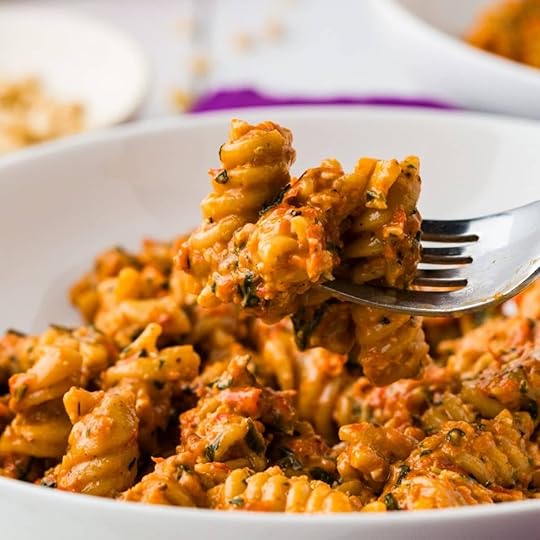
This Roasted Red Pepper Pesto Pasta is an excellent choice for those following a CKD-friendly diet, as it focuses on low-potassium, low-sodium ingredients that support kidney health. The use of heart-healthy olive oil, fresh basil, and red bell peppers provides essential nutrients while keeping the dish light on components that can stress the kidneys, making it a flavorful, nourishing option for anyone managing CKD.
We love trying new kidney friendly vegetarian recipes, and this one is made with our pepper pesto sauce! Eating some delicious kidney friendly side dishes for your meal makes it one that can fill you up and keep your diet on track.
[feast_advanced_jump_to]Ingredients In Red Pepper Pesto PastaThis Roasted Pepper Pesto Pasta comes together with a simple blend of fresh, kidney-friendly ingredients that pack a punch of flavor. From sweet red bell peppers to aromatic basil and heart-healthy olive oil, each component is carefully chosen to support your health while creating a delicious meal.
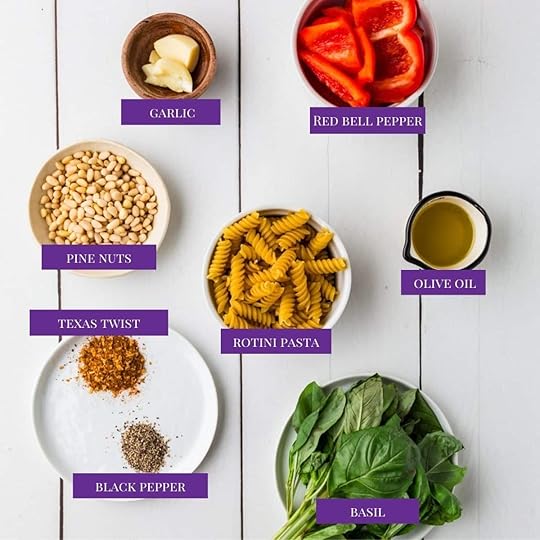 Red Bell Peppers â Rich in vitamin C and antioxidants, red bell peppers provide a flavorful, kidney-friendly addition to the pesto while being low in potassium.Garlic â Garlic adds natural flavor and has anti-inflammatory properties, making it a great choice for a CKD-friendly diet.Pine Nuts â Pine nuts are a good source of healthy fats and protein, supporting kidney health without overwhelming the diet with excess sodium or potassium.Basil â Fresh basil brings aromatic flavor and antioxidants to the pesto, while being low in potassium and ideal for kidney-friendly meals.Black Pepper â Black pepper enhances flavor with minimal sodium content, offering a beneficial spice for CKD-friendly dishes.Olive Oil â Olive oil is a heart-healthy fat that helps lower inflammation, making it a great option for kidney health.Texas Twist â This seasoning adds a unique, flavorful kick without relying on high-sodium ingredients, supporting kidney-friendly eating.Rotini Pasta â Rotini pasta provides a satisfying base for the pesto while offering a low-potassium option when consumed in moderation.
Red Bell Peppers â Rich in vitamin C and antioxidants, red bell peppers provide a flavorful, kidney-friendly addition to the pesto while being low in potassium.Garlic â Garlic adds natural flavor and has anti-inflammatory properties, making it a great choice for a CKD-friendly diet.Pine Nuts â Pine nuts are a good source of healthy fats and protein, supporting kidney health without overwhelming the diet with excess sodium or potassium.Basil â Fresh basil brings aromatic flavor and antioxidants to the pesto, while being low in potassium and ideal for kidney-friendly meals.Black Pepper â Black pepper enhances flavor with minimal sodium content, offering a beneficial spice for CKD-friendly dishes.Olive Oil â Olive oil is a heart-healthy fat that helps lower inflammation, making it a great option for kidney health.Texas Twist â This seasoning adds a unique, flavorful kick without relying on high-sodium ingredients, supporting kidney-friendly eating.Rotini Pasta â Rotini pasta provides a satisfying base for the pesto while offering a low-potassium option when consumed in moderation.See recipe card for quantities.
How To Make Red Pepper Pesto PastaNow that you have all the ingredients ready, let's dive into the easy steps to prepare this flavorful and kidney-friendly Roasted Pepper Pesto Pasta. The process is simple, with minimal prep time, allowing you to enjoy a wholesome meal in no time!
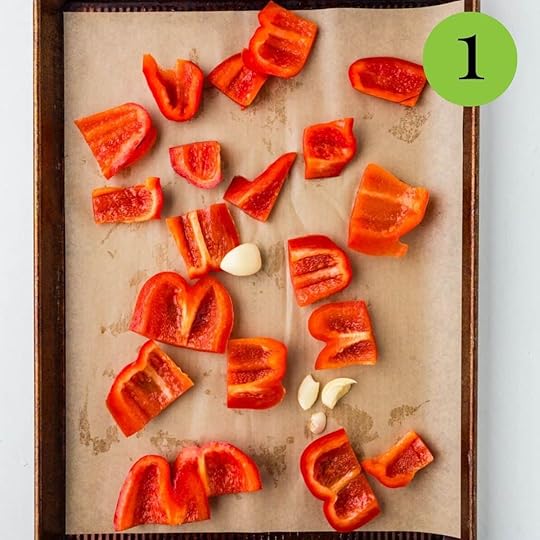 Preheat the oven to 400'FAdd a piece of parchment paper or foil to the bottom of a sheet pan. Add the peppers to a bowl and toss with 1 teaspoon olive oil to coat well. Place the bell peppers skin side down on a large baking sheet. Add the garlic cloves to the sheet. Cook in the oven for 20-25 minutes until the peppers are soft and a little charred if possible.
Preheat the oven to 400'FAdd a piece of parchment paper or foil to the bottom of a sheet pan. Add the peppers to a bowl and toss with 1 teaspoon olive oil to coat well. Place the bell peppers skin side down on a large baking sheet. Add the garlic cloves to the sheet. Cook in the oven for 20-25 minutes until the peppers are soft and a little charred if possible.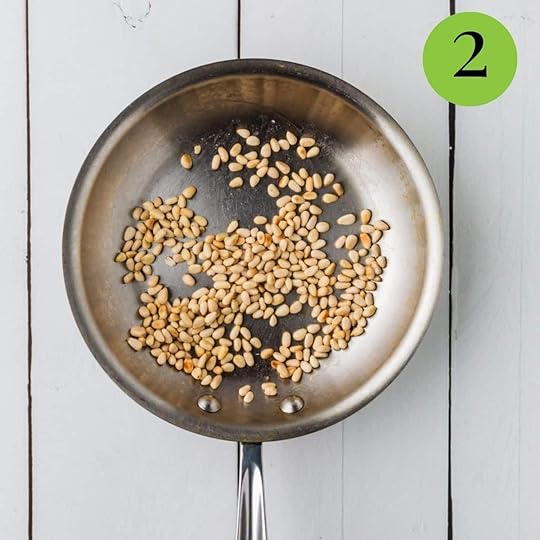
3. While the peppers are cooking, add the pine nuts to a small skillet and roast them for 3-5 minutes in a pan, lightly toasting them.
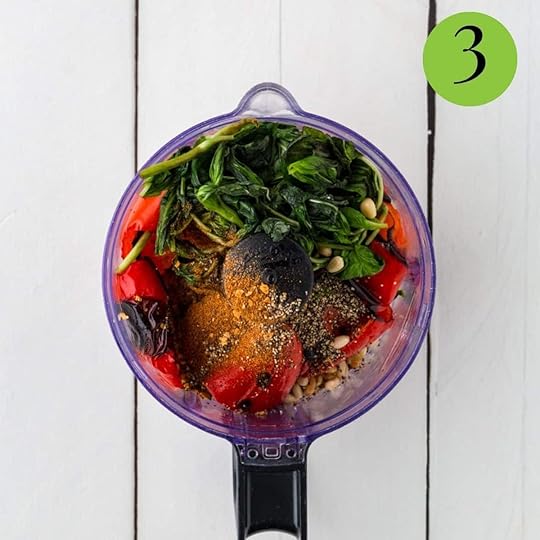
4. Once the peppers are done, add the peppers, Texas twist, garlic, pine nuts, basil and black pepper to a food processor.
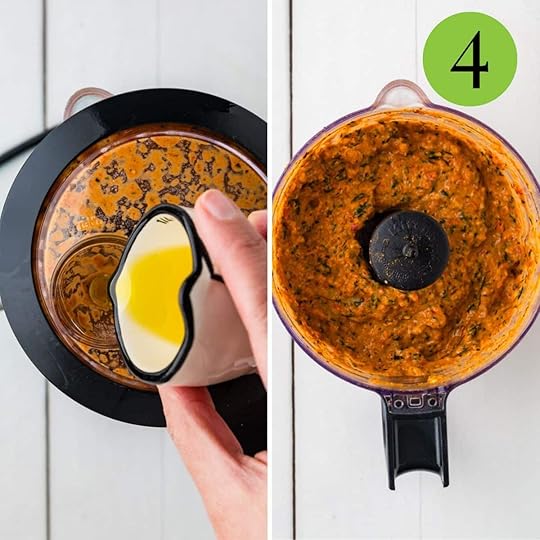
5. Turn on the food processor and blend well. Add rest of olive oil to the mixture and continue to process until the mixture is a nice thick consistency and no more chunks remain.
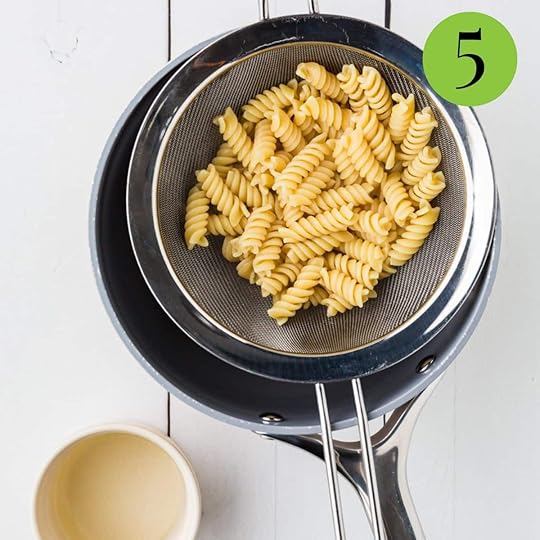
6. Cook the pasta to al dente according to package directions. Drain and reserve ½ cup pasta water.
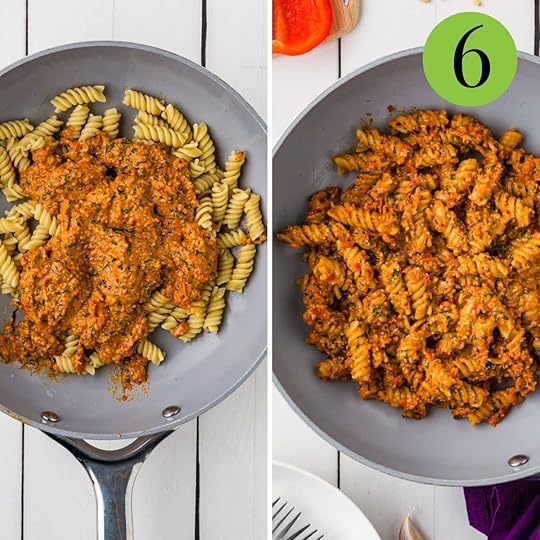
7. Add the cooked pasta to a large skillet, and turn on heat to medium-low. Add pesto and mix thoroughly.
8. Depending on desired thickness of sauce, add pasta water to thin the pesto to desired thickness. I used ¼ cup pasta water.
Hint: Toasting Pine Nuts: Watch the pine nuts closely while toasting, as they can burn quickly. Stir frequently for even roasting.
SubstitutionsThis recipe is flexible, so here are a few kidney-friendly substitutions to make it work for your dietary needs:
Swap Texas Twist: If you don't have Texas Twist seasoning, you can substitute it with a pinch of paprika or a mild chili powder to add a bit of warmth without overwhelming the dish.Substitute Pine Nuts: If you're allergic to pine nuts or prefer a different flavor, try sunflower seeds or walnuts as a tasty alternative.Variations on Red Pepper Pesto RecipeIf you'd like to try variations of this Roasted Pepper Pesto Pasta, here are some kidney-friendly options to suit different preferences:
Use Whole Wheat Pasta: If you want extra fiber in your meal, whole wheat rotini pasta can be a great addition, offering a hearty texture while remaining kidney-friendly.Add Roasted Vegetables: You can include other low-potassium vegetables like zucchini or eggplant to the roasted mix for added flavor and nutrition.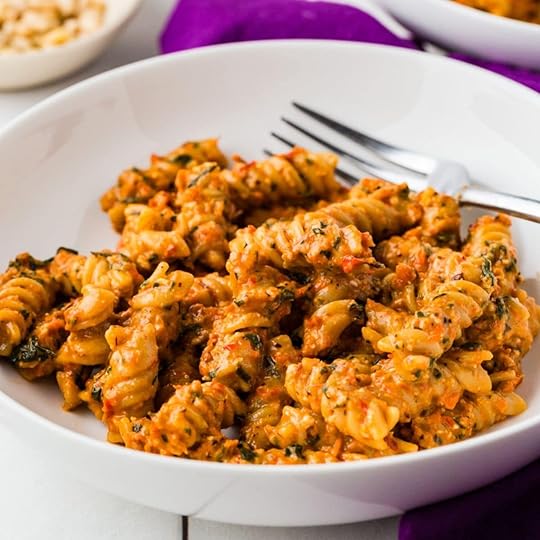 Storage
StorageTo store your Roasted Pepper Pesto Pasta, follow these tips to keep the dish fresh and maintain its CKD-friendly qualities:
Refrigeration: Store any leftover pesto in an airtight container in the refrigerator for up to 3 days. For the pasta, place it in a separate airtight container to prevent it from becoming too soggy.Freezing: If you want to store the pesto for longer, transfer it to a freezer-safe container or ice cube tray. Pesto can be frozen for up to 3 months. When ready to use, thaw it in the refrigerator overnight and mix with freshly cooked pasta.Reheating: To reheat the pasta, gently warm it in a skillet over low heat. If the pesto has thickened in the fridge, add a little reserved pasta water to restore its creamy texture.These simple storage tips help ensure that your Roasted Pepper Pesto Pasta remains fresh and ready to enjoy whenever you need it!
Top TipUse Fresh Basil: Fresh basil is key to a vibrant, flavorful pesto. If you can't find fresh, you could try using basil paste or dried basil, but fresh gives the best result.FAQs about Roasted Red Pepper RecipesCan I use jarred roasted red peppers instead of fresh ones?Yes, jarred roasted red peppers can be a convenient alternative to fresh ones. Choose a brand with no added sodium or preservatives, and rinse them thoroughly to remove excess sodium if youâre following a kidney-friendly diet.
What are some CKD-friendly alternatives to roasted red peppers?If red peppers are unavailable or not suitable for your diet, you can substitute them with roasted yellow or orange bell peppers. They have similar flavors and are low in potassium, making them a great option for CKD patients.
Store leftover roasted red peppers in an airtight container in the refrigerator for up to 5 days. You can also freeze them by laying them flat on a baking sheet to freeze individually before transferring them to a freezer-safe bag or container.
What seasonings can I use to enhance the flavor of roasted red peppers on a CKD diet?To keep the recipe kidney-friendly, use fresh herbs like basil, parsley, or oregano, along with garlic powder, onion powder, or smoked paprika. Avoid high-sodium seasonings like pre-made spice blends unless theyâre specifically labeled as low sodium.
Can roasted red peppers be included in a low-potassium diet?Yes, red bell peppers are naturally low in potassium and can be included in a CKD diet. To ensure you stay within your dietary limits, monitor portion sizes and consult with a healthcare provider if youâre unsure about your potassium intake.
Looking for other recipes like this? Try these:
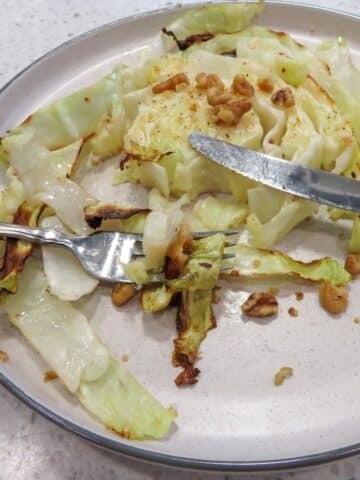 Oven Roasted Cabbage Steaks
Oven Roasted Cabbage Steaks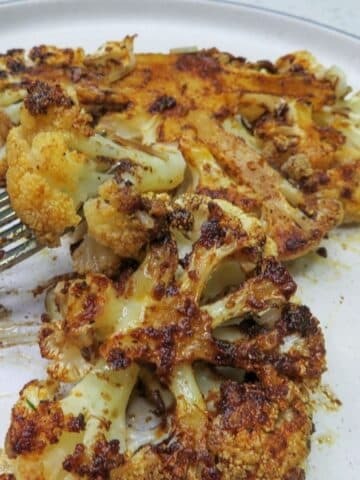 Roasted Cauliflower Steaks with Parmesan
Roasted Cauliflower Steaks with Parmesan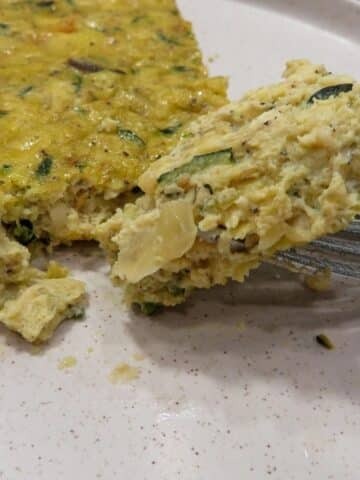 Zucchini Mushroom Frittata
Zucchini Mushroom Frittata Arugula Frittata RecipePairing with Red Pepper Pesto Pasta
Arugula Frittata RecipePairing with Red Pepper Pesto PastaThese are my favorite dishes to serve with your vegetarian pasta:
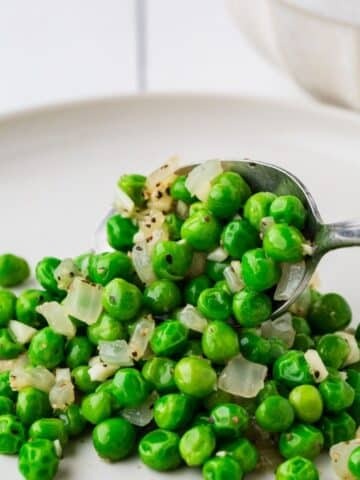 Italian peas
Italian peas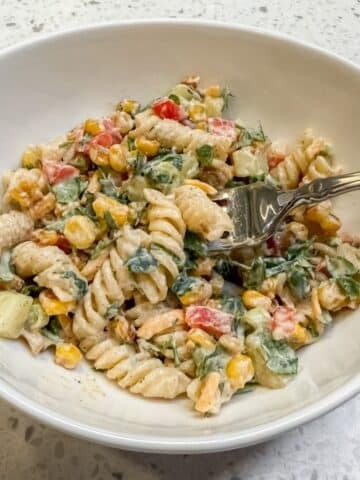 Corn Pasta Salad
Corn Pasta Salad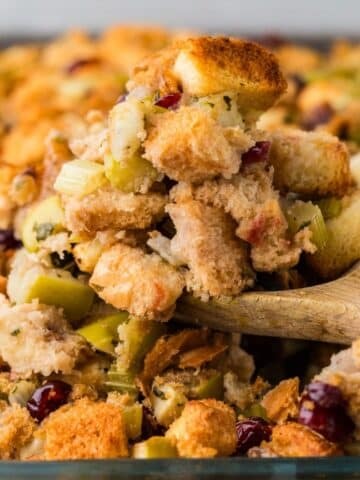 Cranberry Apple Walnut Stuffing
Cranberry Apple Walnut Stuffing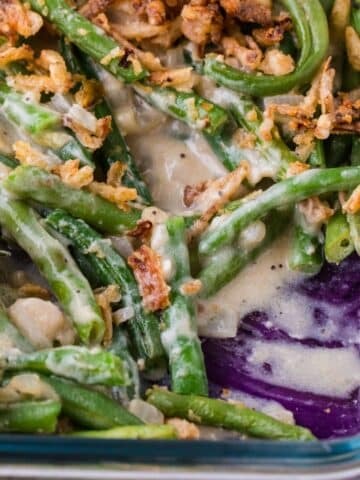 Dairy-Free Green Bean Casserole
Dairy-Free Green Bean CasseroleIf you tried this Recipe or any other recipe on my website, please please leave a star rating and let me know how it goes in the comments below. I love hearing from you!
Recipe PrintRoasted Red Pepper Recipes Pasta#wprm-recipe-user-rating-2 .wprm-rating-star.wprm-rating-star-full svg * { fill: #343434; }#wprm-recipe-user-rating-2 .wprm-rating-star.wprm-rating-star-33 svg * { fill: url(#wprm-recipe-user-rating-2-33); }#wprm-recipe-user-rating-2 .wprm-rating-star.wprm-rating-star-50 svg * { fill: url(#wprm-recipe-user-rating-2-50); }#wprm-recipe-user-rating-2 .wprm-rating-star.wprm-rating-star-66 svg * { fill: url(#wprm-recipe-user-rating-2-66); }linearGradient#wprm-recipe-user-rating-2-33 stop { stop-color: #343434; }linearGradient#wprm-recipe-user-rating-2-50 stop { stop-color: #343434; }linearGradient#wprm-recipe-user-rating-2-66 stop { stop-color: #343434; }#wprm-recipe-user-rating-2.wprm-user-rating-allowed.wprm-user-rating-not-voted:not(.wprm-user-rating-voting) svg * { fill-opacity: 0.3; }Whip up a delicious Roasted Red Pepper Pesto Pasta! This flavorful dish combines roasted red peppers, basil, garlic, and Parmesan for a creamy, vibrant sauce. Perfect for a quick and satisfying meal!Course Entree, Main Course, Side DishCuisine AmericanDiet Diabetic, Low Calorie, Low Salt, VegetarianCook Time 30 minutes minutesTotal Time 30 minutes minutesServings 2Calories 278kcalAuthor Mathea Ford, RDN, LD, MBAIngredients2 large red bell peppers deseeded and cut into large chunks2 cloves garlic¼ pine nuts1 cup basil leaves½ teaspoon black pepper2 tablespoon olive oil1 teaspoon Texas Twist1 cup Rotini PastaGet ingredients with
PrintRoasted Red Pepper Recipes Pasta#wprm-recipe-user-rating-2 .wprm-rating-star.wprm-rating-star-full svg * { fill: #343434; }#wprm-recipe-user-rating-2 .wprm-rating-star.wprm-rating-star-33 svg * { fill: url(#wprm-recipe-user-rating-2-33); }#wprm-recipe-user-rating-2 .wprm-rating-star.wprm-rating-star-50 svg * { fill: url(#wprm-recipe-user-rating-2-50); }#wprm-recipe-user-rating-2 .wprm-rating-star.wprm-rating-star-66 svg * { fill: url(#wprm-recipe-user-rating-2-66); }linearGradient#wprm-recipe-user-rating-2-33 stop { stop-color: #343434; }linearGradient#wprm-recipe-user-rating-2-50 stop { stop-color: #343434; }linearGradient#wprm-recipe-user-rating-2-66 stop { stop-color: #343434; }#wprm-recipe-user-rating-2.wprm-user-rating-allowed.wprm-user-rating-not-voted:not(.wprm-user-rating-voting) svg * { fill-opacity: 0.3; }Whip up a delicious Roasted Red Pepper Pesto Pasta! This flavorful dish combines roasted red peppers, basil, garlic, and Parmesan for a creamy, vibrant sauce. Perfect for a quick and satisfying meal!Course Entree, Main Course, Side DishCuisine AmericanDiet Diabetic, Low Calorie, Low Salt, VegetarianCook Time 30 minutes minutesTotal Time 30 minutes minutesServings 2Calories 278kcalAuthor Mathea Ford, RDN, LD, MBAIngredients2 large red bell peppers deseeded and cut into large chunks2 cloves garlic¼ pine nuts1 cup basil leaves½ teaspoon black pepper2 tablespoon olive oil1 teaspoon Texas Twist1 cup Rotini PastaGet ingredients with  InstructionsPreheat the oven to 400'FAdd a piece of parchment paper or foil to the bottom of a sheet pan. Add the peppers to a bowl and toss with 1 teaspoon olive oil to coat well. Place the bell peppers skin side down on a large baking sheet. Add the garlic cloves to the sheet. Cook in the oven for 20-25 minutes until the peppers are soft and a little charred if possible.While the peppers are cooking, add the pine nuts to a small skillet and roast them for 3-5 minutes in a pan, lightly toasting them.Once the peppers are done, add the peppers, Texas twist, garlic, pine nuts, basil and black pepper to a food processor.Turn on the food processor and blend well. Add rest of olive oil to the mixture and continue to process until the mixture is a nice thick consistency and no more chunks remain.Cook the pasta to al dente according to package directions. Drain and reserve ½ cup pasta water.Add the cooked pasta to a large skillet, and turn on heat to medium-low. Add pesto and mix thoroughly.Depending on desired thickness of sauce, add pasta water to thin the pesto to desired thickness. I used ¼ cup pasta water.NutritionCalories: 278kcal | Carbohydrates: 32g | Protein: 6g | Fat: 15g | Saturated Fat: 2g | Polyunsaturated Fat: 2g | Monounsaturated Fat: 10g | Sodium: 24mg | Potassium: 392mg | Fiber: 4g | Sugar: 6g | Vitamin A: 4658IU | Vitamin C: 155mg | Calcium: 47mg | Iron: 2mg | Phosphorus: 103mgCheck Out Our Meal Plans For People With Chronic Kidney Disease (CKD)
InstructionsPreheat the oven to 400'FAdd a piece of parchment paper or foil to the bottom of a sheet pan. Add the peppers to a bowl and toss with 1 teaspoon olive oil to coat well. Place the bell peppers skin side down on a large baking sheet. Add the garlic cloves to the sheet. Cook in the oven for 20-25 minutes until the peppers are soft and a little charred if possible.While the peppers are cooking, add the pine nuts to a small skillet and roast them for 3-5 minutes in a pan, lightly toasting them.Once the peppers are done, add the peppers, Texas twist, garlic, pine nuts, basil and black pepper to a food processor.Turn on the food processor and blend well. Add rest of olive oil to the mixture and continue to process until the mixture is a nice thick consistency and no more chunks remain.Cook the pasta to al dente according to package directions. Drain and reserve ½ cup pasta water.Add the cooked pasta to a large skillet, and turn on heat to medium-low. Add pesto and mix thoroughly.Depending on desired thickness of sauce, add pasta water to thin the pesto to desired thickness. I used ¼ cup pasta water.NutritionCalories: 278kcal | Carbohydrates: 32g | Protein: 6g | Fat: 15g | Saturated Fat: 2g | Polyunsaturated Fat: 2g | Monounsaturated Fat: 10g | Sodium: 24mg | Potassium: 392mg | Fiber: 4g | Sugar: 6g | Vitamin A: 4658IU | Vitamin C: 155mg | Calcium: 47mg | Iron: 2mg | Phosphorus: 103mgCheck Out Our Meal Plans For People With Chronic Kidney Disease (CKD)The post Roasted Red Pepper Pesto Pasta appeared first on Renal Diet HQ.
December 16, 2024
Hawaiian Chicken Salad
Looking for a flavorful and kidney-friendly meal option? This Hawaiian Chicken Salad combines tender chicken, sweet pineapple, and crunchy almonds in a creamy, low-sodium dressing thatâs perfect for those managing Chronic Kidney Disease (CKD). Whether served as a sandwich or on its own, this refreshing recipe is a delicious and nutritious way to support your kidney health!
As a Registered Dietitian specializing in chronic kidney disease (CKD), I understand the importance of balancing flavor and nutrition in every meal. My goal is to provide kidney-friendly recipes that make it easier for individuals with CKD to enjoy tasty, healthy meals without compromising their health. With years of experience guiding patients on dietary changes, I aim to support individuals in managing their condition through simple, effective nutrition strategies.
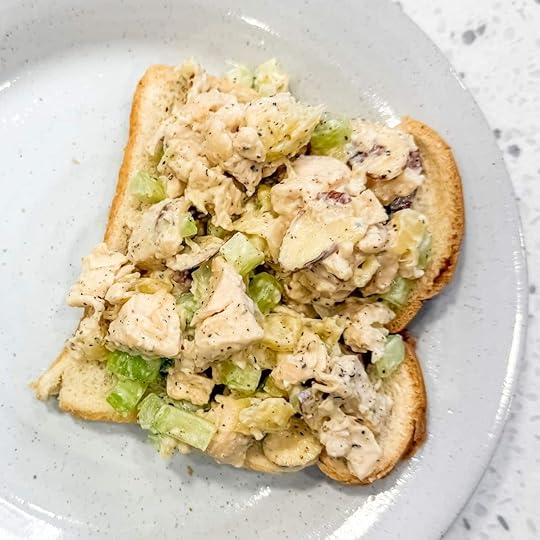
This Chicken Hawaiian Salad is thoughtfully designed to align with CKD dietary needs by using lean chicken breast for high-quality protein and low-sodium, kidney-friendly ingredients like olive oil mayonnaise and garlic powder. The inclusion of crushed pineapple and almonds adds flavor and texture without overwhelming potassium or phosphorus levels, making it a safe and enjoyable choice for those managing their kidney health.
I love making healthy kidney friendly chicken recipes, and it's great to serve this with a kidney friendly salad like our Cherry Fluff Salad or Pineapple Salad.
[feast_advanced_jump_to]IngredientsThis Hawaiian Salad Chicken brings together simple, wholesome ingredients like tender chicken, sweet pineapple, and crunchy almonds to create a perfect balance of flavors and textures. Each ingredient is carefully chosen to be both delicious and kidney-friendly, ensuring a satisfying meal youâll love!
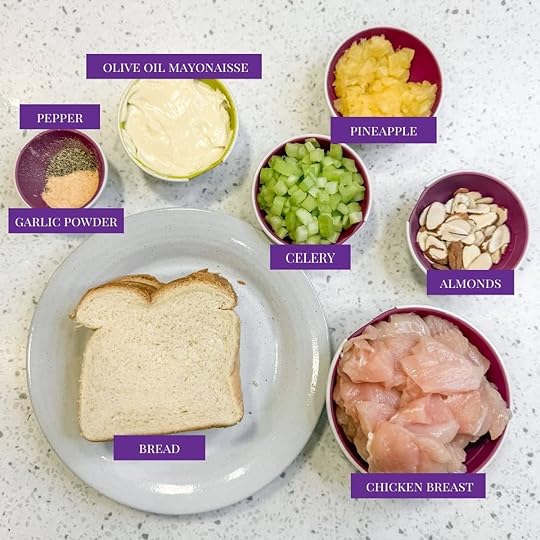 Chicken breast: A lean source of high-quality protein that helps support muscle maintenance without excessive phosphorus or potassium.Celery: Adds a refreshing crunch and mild flavor while being low in sodium and potassium.Crushed pineapple: Provides natural sweetness and a tropical flavor while being lower in potassium compared to other fruits.Olive oil mayonnaise: A kidney-friendly alternative to traditional mayo, offering healthy fats with reduced sodium.Pepper: Enhances the dish's flavor without the need for added salt, helping to maintain lower sodium levels.Garlic powder: Adds depth of flavor while being a low-sodium seasoning option for kidney health.Sliced almonds: Contribute a nutty crunch and healthy fats, adding texture and nutrients in moderation.White or wheat bread: Acts as a neutral base for the salad, with white bread often being lower in potassium and phosphorus for CKD diets.
Chicken breast: A lean source of high-quality protein that helps support muscle maintenance without excessive phosphorus or potassium.Celery: Adds a refreshing crunch and mild flavor while being low in sodium and potassium.Crushed pineapple: Provides natural sweetness and a tropical flavor while being lower in potassium compared to other fruits.Olive oil mayonnaise: A kidney-friendly alternative to traditional mayo, offering healthy fats with reduced sodium.Pepper: Enhances the dish's flavor without the need for added salt, helping to maintain lower sodium levels.Garlic powder: Adds depth of flavor while being a low-sodium seasoning option for kidney health.Sliced almonds: Contribute a nutty crunch and healthy fats, adding texture and nutrients in moderation.White or wheat bread: Acts as a neutral base for the salad, with white bread often being lower in potassium and phosphorus for CKD diets.See recipe card for quantities.
How To Make Hawaiian Chicken Salad MixWith all your ingredients ready, itâs time to bring this flavorful Hawaiian Chicken Salad to life. Follow these simple steps to create a delicious, kidney-friendly dish in no time!

1. Put a medium saucepan on the stove, and turn on to medium-high. Add chicken and cook until no longer pink in the middle on the stovetop. Drain excess fat and fluid. Dice into smaller pieces.

2. Add chicken, celery, pineapple, mayonnaise, pepper, garlic powder, and almonds to the bowl. Mix together well.
Hint: Cook the chicken thoroughly and dice it into smaller pieces while warm for easier blending with the other ingredients.
SubstitutionsFor even greater flexibility, consider these substitutions to suit specific dietary requirements or ingredient availability:
Sunflower seeds: Use sunflower seeds instead of almonds for those with nut allergies, maintaining the crunch without compromising kidney health.Lettuce wraps: Serve the chicken salad in large lettuce leaves instead of bread for a low-carb, potassium-conscious option. Variations
VariationsThis recipe can be easily adapted to suit different preferences and dietary needs while staying kidney-friendly. Here are three variations to try:
Tropical Twist: Add a tablespoon of shredded coconut for extra sweetness and a tropical vibe.Vegetarian Option: Swap the chicken for firm tofu cubes and increase the almonds for a plant-based protein boost.Herb-Infused Flavor: Mix in a teaspoon of fresh chopped parsley or dill for a refreshing herbal touch.StorageTo keep your Hawaiian Chicken Salad fresh and CKD-friendly, follow these storage tips:
Refrigeration: Store the salad in an airtight container in the refrigerator for up to 3 days. This helps preserve its flavors and ensures food safety.Bread Separately: If making sandwiches, store the salad and bread separately to prevent sogginess. Assemble the sandwiches just before serving.Freezing Not Recommended: Avoid freezing this salad, as the mayonnaise and pineapple can change texture and compromise the dishâs taste and quality.By properly storing your chicken salad, you can enjoy this kidney-friendly dish whenever youâre ready!
Top TipToast the sliced almonds lightly before mixing them in for added flavor and a satisfying crunch.FAQCan I use rotisserie chicken instead of raw chicken breast?Yes, but ensure the rotisserie chicken is unseasoned or low-sodium to keep the recipe CKD-friendly.
Whatâs the best way to prepare this for a low-carb diet?Skip the bread and serve the salad in lettuce wraps or on a bed of romaine lettuce for a satisfying low-carb meal.
Can I add more vegetables to the salad?Absolutely! Low-potassium vegetables like diced bell peppers or shredded carrots are excellent additions for extra crunch and nutrition.
Looking for other recipes like this? Try these:
 Hawaiian Chicken Salad
Hawaiian Chicken Salad Corn Pasta Salad
Corn Pasta Salad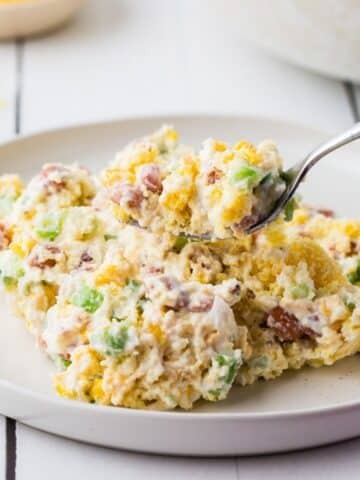 Cornbread Salad
Cornbread Salad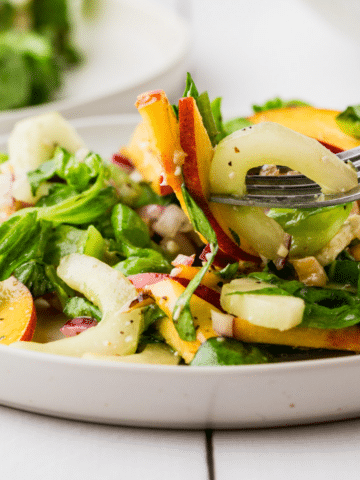 Nectarine SaladPairing For A Kidney Friendly Meal
Nectarine SaladPairing For A Kidney Friendly MealThese are my favorite dishes to serve with Hawaiian Salad Chicken:
 Wild Rice Stuffing
Wild Rice Stuffing Frozen Blackeyed Peas Recipe
Frozen Blackeyed Peas Recipe Italian peas
Italian peas Sugar Free Applesauce
Sugar Free ApplesauceIf you tried this Recipe or any other recipe on my website, please please leave a star rating and let me know how it goes in the comments below. I love hearing from you!
Recipe PrintHawaiian Chicken Salad Recipe With Pineapple#wprm-recipe-user-rating-0 .wprm-rating-star.wprm-rating-star-full svg * { fill: #343434; }#wprm-recipe-user-rating-0 .wprm-rating-star.wprm-rating-star-33 svg * { fill: url(#wprm-recipe-user-rating-0-33); }#wprm-recipe-user-rating-0 .wprm-rating-star.wprm-rating-star-50 svg * { fill: url(#wprm-recipe-user-rating-0-50); }#wprm-recipe-user-rating-0 .wprm-rating-star.wprm-rating-star-66 svg * { fill: url(#wprm-recipe-user-rating-0-66); }linearGradient#wprm-recipe-user-rating-0-33 stop { stop-color: #343434; }linearGradient#wprm-recipe-user-rating-0-50 stop { stop-color: #343434; }linearGradient#wprm-recipe-user-rating-0-66 stop { stop-color: #343434; }#wprm-recipe-user-rating-0.wprm-user-rating-allowed.wprm-user-rating-not-voted:not(.wprm-user-rating-voting) svg * { fill-opacity: 0.3; }Enjoy a tropical twist with Hawaiian Chicken Salad! Juicy chicken, celery, pineapple, and almonds blend perfectly for a flavorful sandwich filling.Course Appetizer, Entree, Main CourseCuisine AmericanDiet Diabetic, Low Calorie, Low Fat, Low SaltPrep Time 10 minutes minutesCook Time 20 minutes minutesTotal Time 30 minutes minutesServings 4Calories 292kcalAuthor Mathea Ford, RDN, LD, MBAEquipment1 Skillet1 Chef's Knife1 Large BowlIngredients1 pound chicken breast raw, cubed½ cup celery diced¼ cup crushed pineapple drained and squeeze out excess juiceâ
cup olive oil mayonnaise½ teaspoon pepper½ teaspoon garlic powder2 tablespoon almonds sliced4 slices white breadGet ingredients with
PrintHawaiian Chicken Salad Recipe With Pineapple#wprm-recipe-user-rating-0 .wprm-rating-star.wprm-rating-star-full svg * { fill: #343434; }#wprm-recipe-user-rating-0 .wprm-rating-star.wprm-rating-star-33 svg * { fill: url(#wprm-recipe-user-rating-0-33); }#wprm-recipe-user-rating-0 .wprm-rating-star.wprm-rating-star-50 svg * { fill: url(#wprm-recipe-user-rating-0-50); }#wprm-recipe-user-rating-0 .wprm-rating-star.wprm-rating-star-66 svg * { fill: url(#wprm-recipe-user-rating-0-66); }linearGradient#wprm-recipe-user-rating-0-33 stop { stop-color: #343434; }linearGradient#wprm-recipe-user-rating-0-50 stop { stop-color: #343434; }linearGradient#wprm-recipe-user-rating-0-66 stop { stop-color: #343434; }#wprm-recipe-user-rating-0.wprm-user-rating-allowed.wprm-user-rating-not-voted:not(.wprm-user-rating-voting) svg * { fill-opacity: 0.3; }Enjoy a tropical twist with Hawaiian Chicken Salad! Juicy chicken, celery, pineapple, and almonds blend perfectly for a flavorful sandwich filling.Course Appetizer, Entree, Main CourseCuisine AmericanDiet Diabetic, Low Calorie, Low Fat, Low SaltPrep Time 10 minutes minutesCook Time 20 minutes minutesTotal Time 30 minutes minutesServings 4Calories 292kcalAuthor Mathea Ford, RDN, LD, MBAEquipment1 Skillet1 Chef's Knife1 Large BowlIngredients1 pound chicken breast raw, cubed½ cup celery diced¼ cup crushed pineapple drained and squeeze out excess juiceâ
cup olive oil mayonnaise½ teaspoon pepper½ teaspoon garlic powder2 tablespoon almonds sliced4 slices white breadGet ingredients with  InstructionsPut a medium saucepan on the stove, and turn on to medium-high. Add chicken and cook until no longer pink in the middle on the stovetop. Drain excess fat and fluid. Dice into smaller pieces.1 pound chicken breastAdd chicken, celery, pineapple, mayonnaise, pepper, garlic powder, and almonds to the bowl. Mix together well. ½ cup celery, ¼ cup crushed pineapple, â
cup olive oil mayonnaise, ½ teaspoon pepper, 2 tablespoon almonds, ½ teaspoon garlic powder3. Serve on bread, folding bread in half for a sandwich.4 slices white breadNutritionCalories: 292kcal | Carbohydrates: 19g | Protein: 28g | Fat: 11g | Saturated Fat: 2g | Polyunsaturated Fat: 4g | Monounsaturated Fat: 4g | Trans Fat: 0.03g | Cholesterol: 76mg | Sodium: 429mg | Potassium: 560mg | Fiber: 2g | Sugar: 5g | Vitamin A: 113IU | Vitamin C: 3mg | Vitamin D: 0.1µg | Calcium: 64mg | Iron: 2mg | Phosphorus: 307mgCheck Out Our Meal Plans For People With Chronic Kidney Disease (CKD)
InstructionsPut a medium saucepan on the stove, and turn on to medium-high. Add chicken and cook until no longer pink in the middle on the stovetop. Drain excess fat and fluid. Dice into smaller pieces.1 pound chicken breastAdd chicken, celery, pineapple, mayonnaise, pepper, garlic powder, and almonds to the bowl. Mix together well. ½ cup celery, ¼ cup crushed pineapple, â
cup olive oil mayonnaise, ½ teaspoon pepper, 2 tablespoon almonds, ½ teaspoon garlic powder3. Serve on bread, folding bread in half for a sandwich.4 slices white breadNutritionCalories: 292kcal | Carbohydrates: 19g | Protein: 28g | Fat: 11g | Saturated Fat: 2g | Polyunsaturated Fat: 4g | Monounsaturated Fat: 4g | Trans Fat: 0.03g | Cholesterol: 76mg | Sodium: 429mg | Potassium: 560mg | Fiber: 2g | Sugar: 5g | Vitamin A: 113IU | Vitamin C: 3mg | Vitamin D: 0.1µg | Calcium: 64mg | Iron: 2mg | Phosphorus: 307mgCheck Out Our Meal Plans For People With Chronic Kidney Disease (CKD)The post Hawaiian Chicken Salad appeared first on Renal Diet HQ.
December 13, 2024
Kidney-Friendly Breakfast Ideas Perfect for Dialysis Patients-Podcast

Chronic Kidney Disease (CKD) affects millions worldwide, requiring dietary adjustments to manage symptoms and prevent complications. For those on dialysis, nutrition plays a pivotal role in overall health and well-being. Breakfast, as the first meal of the day, sets the tone for energy and nourishment. Choosing the right options ensures dialysis patients meet their unique nutritional needs without overloading their bodies with harmful substances.
For More Recipes and Ideas --->> Get Your Free Meals and Recipes That Are Perfect for Pre-Dialysis Diets, Pre-Dialysis with Diabetes, or Dialysis Diets.
Low-Sodium Breakfast OptionsMaintaining low sodium levels is crucial for dialysis patients to manage blood pressure and prevent fluid retention. Here are some delicious, low-sodium breakfast ideas:
Savory Dishes:Vegetable Omelets: Load your omelet with zucchini, bell peppers, and onions. Season with garlic powder, turmeric, or fresh herbs like basil and oregano instead of salt.Avocado Toast: Spread unsalted avocado on whole-grain bread. Add slices of tomato and a dash of cracked black pepper for flavor.Sweet Options:Berry Smoothies: Blend fresh or frozen berries with almond or coconut milk for a naturally sweet, nutrient-packed drink.Whole Wheat Pancakes: Use whole wheat flour to create pancakes, topping them with unsalted butter and a drizzle of honey for a wholesome start.Low-Potassium Breakfast IdeasDialysis patients often need to limit potassium intake to prevent complications. These breakfasts strike a balance between flavor and safety:
Vegetable-Based:Low-Potassium Frittata: Use zucchini, red bell peppers, and onions in your frittata. These vegetables are lower in potassium and add vibrant flavors.Grains and Dairy:Buckwheat Pancakes: A nutritious alternative to traditional pancakes, paired with Greek yogurt or a dollop of almond butter.Overnight Oats: Soak oats in almond milk and top with fresh strawberries or blueberries for a satisfying meal.Low-Phosphorus Breakfast OptionsManaging phosphorus levels is another critical consideration. These breakfast options keep phosphorus in check:
Protein and Grains:Whole-Grain Toast with Peanut Butter: Opt for low-phosphorus peanut butter or jam for a quick and satisfying choice.Egg-Based Dishes: Scrambled eggs paired with steamed vegetables make for a filling, phosphorus-conscious breakfast.Dairy-Free Alternatives:Smoothies with Coconut Milk: Blend fruits like strawberries and a handful of oats for a creamy, phosphorus-free option.Chia Pudding: Mix chia seeds with almond milk and let it set overnight. Add fresh berries in the morning.High-Protein Breakfast ChoicesProtein is essential for dialysis patients to maintain muscle mass and energy. Here are high-protein breakfast ideas:
Egg-Based Options:Scrambled Eggs: Cooked in olive oil and served with a side of lean chicken or turkey slices.Omelets: Packed with kidney-friendly vegetables like onions and red peppers.Dairy and Alternatives:Greek Yogurt Parfait: Layer Greek yogurt with granola and fresh berries for a protein boost.Quinoa Breakfast Porridge: Cook quinoa with almond milk and top with dried cranberries or chopped almonds.Healthy Fat-Inclusive BreakfastHealthy fats support heart health and overall energy. Incorporate these into your breakfast:
Savory Options:Avocado and Eggs: Serve scrambled eggs with avocado slices drizzled with olive oil.Salmon Omelet: Add omega-3-rich salmon to your omelet for a flavorful twist.Sweet Options:Nut Butter Toast: Spread almond or cashew butter on whole-grain bread.Yogurt Parfait: Top unsweetened yogurt with a handful of walnuts and a drizzle of honey.Complex Carbohydrate OptionsComplex carbs provide sustained energy and are essential for a balanced diet. These options are dialysis-friendly:
Grain-Based:Whole-Grain Cereal: Choose cereals with low sodium and no added sugars. Add almond milk and a sprinkle of cinnamon.Oatmeal: Cook oatmeal with water or almond milk and add fresh fruits like blueberries.Toast and Toppings:Whole-Wheat Toast: Top with nut butter or low-sugar jam for a simple and satisfying meal.Breakfast Burrito: Use a whole-wheat tortilla filled with scrambled eggs and sautéed vegetables.Fiber-Rich ChoicesFiber aids digestion and helps maintain blood sugar levels. Try these breakfast ideas:
Oatmeal Variations:Add chia seeds, ground flaxseed, or a handful of walnuts for extra fiber.Smoothie Bowls:Blend spinach, almond milk, and low-potassium fruits like berries. Top with granola and chia seeds.Beans for Breakfast:Add black beans to a breakfast scramble for a unique, fiber-rich twist.Creative Breakfast IdeasVariety keeps breakfast exciting. Here are some creative ideas:
Savory Porridge:Cook quinoa or millet and top with fresh herbs, olive oil, and a sprinkle of parmesan.Smoothie Bowls:Create a base with low-potassium fruits and almond milk. Add toppings like unsweetened coconut flakes and granola.Customized Combos:Swap cheese with avocado in egg dishes or use honey instead of syrup for pancakes.Dialysis patients should always consult their dietitian or healthcare provider to tailor these ideas to their individual needs. With the right choices, breakfast can be a delightful and nourishing way to start the day.
Learn more about Can I Eat Tomatoes on a Renal Diet?
The post Kidney-Friendly Breakfast Ideas Perfect for Dialysis Patients-Podcast appeared first on Renal Diet HQ.
December 9, 2024
Wild Rice Stuffing
Looking for a flavorful, kidney-friendly dish thatâs perfect for any occasion? This Wild Rice Stuffing combines wholesome ingredients like a hearty wild rice blend, crisp apples, and a medley of herbs to create a delicious side dish thatâs low in sodium and packed with nutrients. Whether itâs for a holiday table or a cozy family dinner, this recipe is a satisfying, CKD-friendly alternative to traditional stuffing!
With over 25 years of experience as a Registered Dietitian, I specialize in creating recipes tailored to individuals managing Chronic Kidney Disease (CKD). My passion for kidney-friendly nutrition stems from helping my own family members navigate their health journeys, inspiring me to develop meals that are both nourishing and delicious. This recipe combines my professional expertise with a deep understanding of CKD dietary needs, ensuring itâs as safe as it is satisfying.
[image error]This Wild Rice Stuffing is an excellent choice for those following a CKD-friendly diet, as it is low in sodium and potassium, which are crucial for kidney health. The use of low-sodium vegetable broth, fresh herbs, and kidney-friendly ingredients like apples and pecans ensures that this dish supports proper fluid balance and heart health, while providing a nutritious, satisfying alternative to traditional stuffing.
This is a perfect side dish for a kidney friendly diet, but you might like some of our other apple dishes like our unsweetened applesauce, walnut and cranberry stuffing, vegan apple dessert, or gala apple cake.
[feast_advanced_jump_to]IngredientsThis Wild Rice Stuffing combines wholesome ingredients like a wild rice blend, fresh vegetables, apples, and savory herbs, creating a flavorful and kidney-friendly side dish. Each component is carefully selected to provide a delicious balance of taste and nutrition, making it perfect for those with CKD.
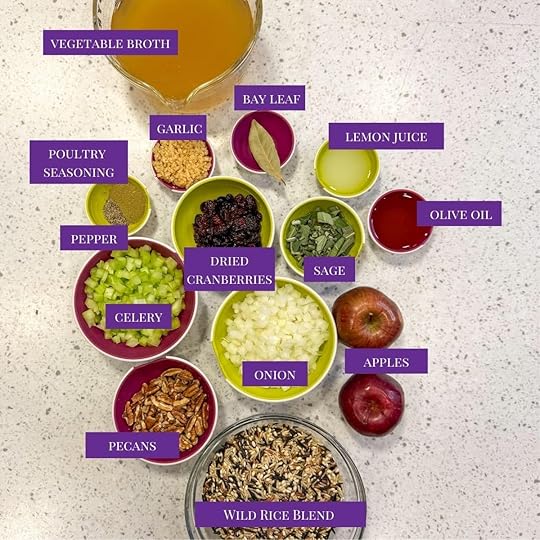 Wild rice blend: A nutritious and fiber-rich base that is lower in potassium compared to other grains, making it suitable for kidney health.Low-sodium vegetable broth: Adds flavor without excessive sodium, helping manage blood pressure and fluid balance.Bay leaf: Enhances the dish's aroma and depth without contributing additional sodium or phosphorus.Olive oil: A heart-healthy fat that supports cardiovascular health, essential for CKD management.Onion: Adds a savory flavor while being low in potassium and phosphorus, ideal for a renal diet.Celery: Provides crunch and texture with a modest potassium content when used in moderation.Poultry seasoning: Offers a blend of herbs and spices to amplify flavor without the need for salt.Garlic: Boosts flavor and offers potential anti-inflammatory benefits without adding sodium.Apples: Add natural sweetness and fiber while being a kidney-friendly fruit choice.Lemon juice: Brightens the dishâs flavors and provides a source of vitamin C without adding potassium.Pecans: Provide a nutty crunch and are lower in potassium and phosphorus than many other nuts when portioned appropriately.Dried cranberries: Add a tart sweetness and are low in potassium, making them suitable for CKD diets in small amounts.Fresh sage: Brings a warm, earthy flavor while being a kidney-friendly herb.Would you like any of these explanations expanded or adjusted?
Wild rice blend: A nutritious and fiber-rich base that is lower in potassium compared to other grains, making it suitable for kidney health.Low-sodium vegetable broth: Adds flavor without excessive sodium, helping manage blood pressure and fluid balance.Bay leaf: Enhances the dish's aroma and depth without contributing additional sodium or phosphorus.Olive oil: A heart-healthy fat that supports cardiovascular health, essential for CKD management.Onion: Adds a savory flavor while being low in potassium and phosphorus, ideal for a renal diet.Celery: Provides crunch and texture with a modest potassium content when used in moderation.Poultry seasoning: Offers a blend of herbs and spices to amplify flavor without the need for salt.Garlic: Boosts flavor and offers potential anti-inflammatory benefits without adding sodium.Apples: Add natural sweetness and fiber while being a kidney-friendly fruit choice.Lemon juice: Brightens the dishâs flavors and provides a source of vitamin C without adding potassium.Pecans: Provide a nutty crunch and are lower in potassium and phosphorus than many other nuts when portioned appropriately.Dried cranberries: Add a tart sweetness and are low in potassium, making them suitable for CKD diets in small amounts.Fresh sage: Brings a warm, earthy flavor while being a kidney-friendly herb.Would you like any of these explanations expanded or adjusted?See recipe card for quantities.
How To Make Wild Rice StuffingNow that you have all the ingredients ready, letâs dive into the simple steps to prepare this delicious and kidney-friendly Wild Rice Gluten Free Stuffing. Follow these easy instructions to create a flavorful side dish thatâs sure to impress!
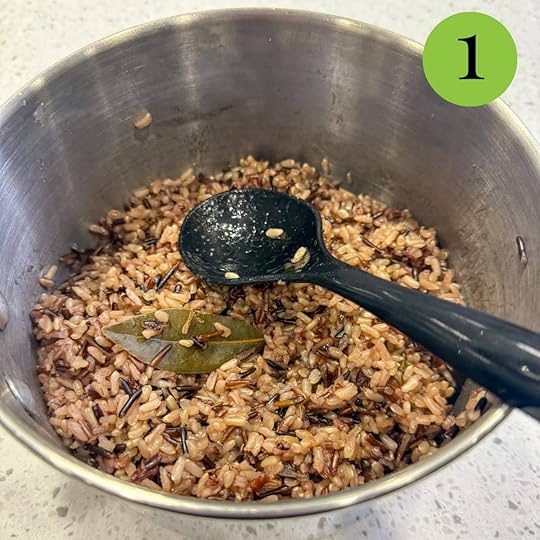 Cook the wild rice blend in a medium sized sauce pan. Add the wild rice, vegetable broth, and bay leaf. Bring to a boil, turn down to a simmer and cover. Cook for 45 minutes. Remove pan from heat and set aside. Remove bay leaf.Preheat the oven to 325'F.
Cook the wild rice blend in a medium sized sauce pan. Add the wild rice, vegetable broth, and bay leaf. Bring to a boil, turn down to a simmer and cover. Cook for 45 minutes. Remove pan from heat and set aside. Remove bay leaf.Preheat the oven to 325'F.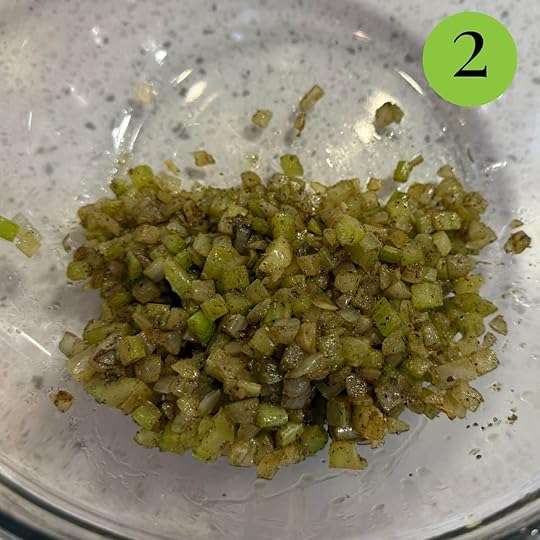
3. While the wild rice is cooking, heat 1 tablespoon vegetable oil in a medium skillet. Add the onion, celery, poultry seasoning, and pepper. Cook on medium heat until softened, about 7-10 minutes. Stir in the garlic and cook for 1 minute more. Transfer to a large bowl and set aside.

4. Heat 1 tablespoon oil in the same pan, and add in the apple cubes. Saute, stirring frequently until lightly browned for about 7-10 minutes. Remove from heat and stir in lemon juice.
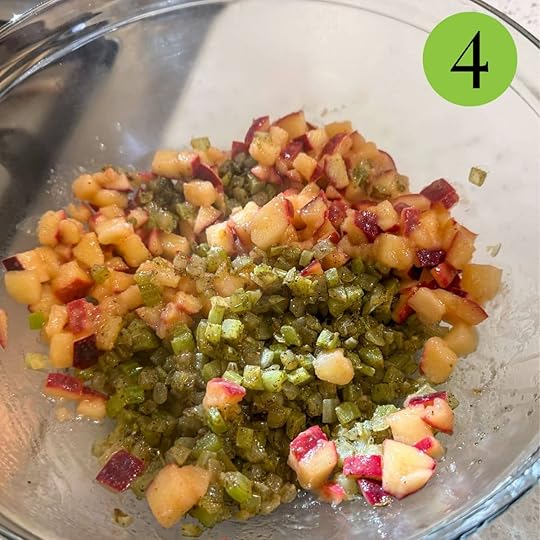
5. Put the cooked apples and wild rice blend into the bowl with the onion and celery mixture. Add in the pecans, cranberries and sage. Stir together.
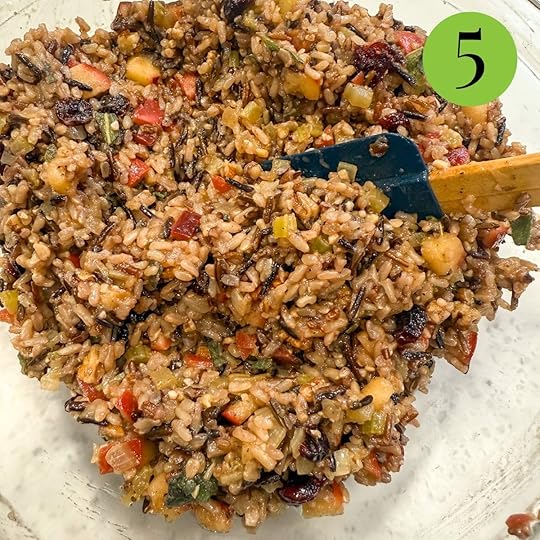

6. Transfer the mixture to a 9 x 13 casserole dish and heat uncovered in the oven for 25 minutes.
Hint: Adjust Consistency: If the stuffing seems too dry after baking, add a little more low-sodium vegetable broth and stir gently to achieve your desired texture.
CKD-Friendly Variations:There are plenty of ways to customize this Wild Rice Stuffing to fit your tastes while keeping it kidney-friendly. Here are a few ideas to get creative while still supporting your health needs:
Vegetable Medley: Swap in other kidney-friendly vegetables like carrots, bell peppers, or zucchini for added color and nutrients.Herb Boost: Add more herbs like thyme, rosemary, or parsley for a more aromatic flavor profile.Gluten-Free Option: Ensure the vegetable broth and any added seasonings are gluten-free to make the recipe suitable for those with gluten sensitivities. Storage
StorageTo keep your Wild Rice Stuffing fresh and preserve its CKD-friendly qualities, follow these storage tips:
Reheating: To avoid drying out the stuffing, add a splash of low-sodium vegetable broth before reheating. Cover it with foil and warm it in the oven, or reheat it in the microwave with a damp paper towel to retain moisture.Refrigeration: Store any leftover stuffing in an airtight container in the refrigerator for up to 3-4 days. Be sure to cool the stuffing to room temperature before refrigerating to maintain its texture.Freezing: For longer storage, freeze the stuffing in a freezer-safe container or resealable bag for up to 2-3 months. When ready to eat, thaw in the refrigerator overnight and reheat in the oven at 325°F until heated through.Top TipEven Baking: Stir the stuffing halfway through the baking time to ensure it heats evenly and doesnât dry out on top.
FAQCan I make this Wild Rice Stuffing ahead of time?Yes, you can prepare the stuffing up to a day in advance. Simply follow the recipe, allow it to cool, and store it in the refrigerator in an airtight container. Reheat it in the oven with a little added vegetable broth to keep it moist.
How can I reduce the sugar content in this recipe?To lower the sugar, you can reduce or eliminate the dried cranberries, or swap them out for a lower-sugar dried fruit like unsweetened dried apples or apricots.
Can I freeze this stuffing?Yes, this stuffing freezes well. Allow it to cool completely before transferring to a freezer-safe container. It can be stored for up to 2-3 months, and reheated by adding a little vegetable broth to maintain moisture.
Other Vegetarian RecipesLooking for other recipes like this Wild Rice Stuffing? Try these:
 Wild Rice Stuffing
Wild Rice Stuffing Vegetable Stuffing
Vegetable Stuffing Dairy Free Creme Brulee
Dairy Free Creme Brulee Oven Roasted Cabbage SteaksPairing with Wild Rice Stuffing
Oven Roasted Cabbage SteaksPairing with Wild Rice StuffingThese are my favorite dishes to serve with the gluten free side dish:
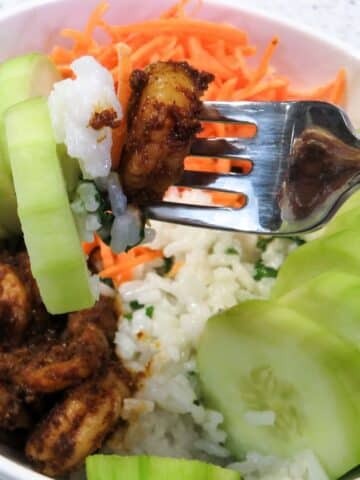 Coconut Shrimp Bowl
Coconut Shrimp Bowl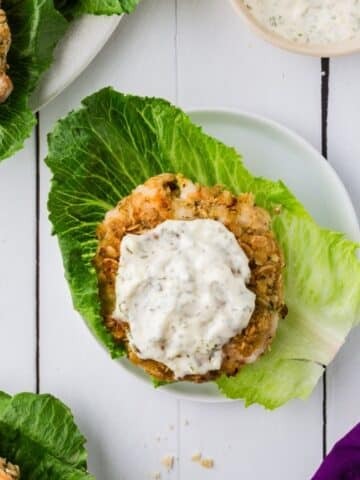 Shrimp Burgers
Shrimp Burgers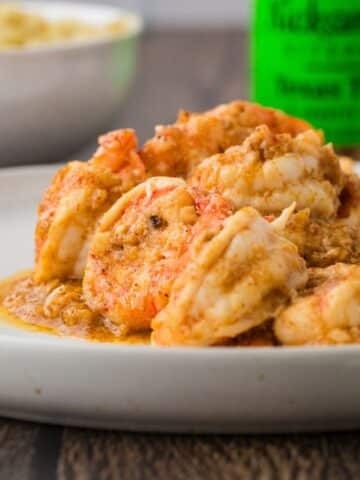 Spicy Lemon Garlic Shrimp 10 Minute Recipe
Spicy Lemon Garlic Shrimp 10 Minute RecipeIf you tried this Recipe or any other recipe on my website, please please leave a star rating and let me know how it goes in the comments below. I love hearing from you!
Recipe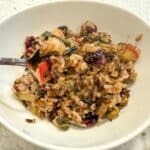 PrintWild Rice Stuffing#wprm-recipe-user-rating-0 .wprm-rating-star.wprm-rating-star-full svg * { fill: #343434; }#wprm-recipe-user-rating-0 .wprm-rating-star.wprm-rating-star-33 svg * { fill: url(#wprm-recipe-user-rating-0-33); }#wprm-recipe-user-rating-0 .wprm-rating-star.wprm-rating-star-50 svg * { fill: url(#wprm-recipe-user-rating-0-50); }#wprm-recipe-user-rating-0 .wprm-rating-star.wprm-rating-star-66 svg * { fill: url(#wprm-recipe-user-rating-0-66); }linearGradient#wprm-recipe-user-rating-0-33 stop { stop-color: #343434; }linearGradient#wprm-recipe-user-rating-0-50 stop { stop-color: #343434; }linearGradient#wprm-recipe-user-rating-0-66 stop { stop-color: #343434; }#wprm-recipe-user-rating-0.wprm-user-rating-allowed.wprm-user-rating-not-voted:not(.wprm-user-rating-voting) svg * { fill-opacity: 0.3; }This Wild Rice Stuffing is a delicious and kidney-friendly side dish made with wholesome ingredients like wild rice, apples, and fresh herbs. Perfect for those with CKD, it offers a nutritious alternative to traditional stuffing while supporting overall health.Course Side DishCuisine American, MediterraneanDiet Low Fat, Low Lactose, Low Salt, Vegan, VegetarianPrep Time 15 minutes minutesCook Time 1 hour hour 10 minutes minutesTotal Time 1 hour hour 25 minutes minutesServings 8Calories 254kcalAuthor Mathea Ford, RDN, LD, MBAEquipment1 Casserole Dish1 SkilletIngredients1 ½ cup wild rice blend Lundberg Wild Rice Blend3 cup low sodium vegetable broth1 bay leaf½ teaspoon pepper2 tablespoon olive oil1 cup diced onion1 cup diced celery1 teaspoon poultry seasoning2 tablespoon minced garlic2 medium apples cored and cut into small cubes (½ in or less)1 tablespoon lemon juice½ cup chopped pecans½ cup dried cranberries2 tablespoon fresh sage choppedGet ingredients with
PrintWild Rice Stuffing#wprm-recipe-user-rating-0 .wprm-rating-star.wprm-rating-star-full svg * { fill: #343434; }#wprm-recipe-user-rating-0 .wprm-rating-star.wprm-rating-star-33 svg * { fill: url(#wprm-recipe-user-rating-0-33); }#wprm-recipe-user-rating-0 .wprm-rating-star.wprm-rating-star-50 svg * { fill: url(#wprm-recipe-user-rating-0-50); }#wprm-recipe-user-rating-0 .wprm-rating-star.wprm-rating-star-66 svg * { fill: url(#wprm-recipe-user-rating-0-66); }linearGradient#wprm-recipe-user-rating-0-33 stop { stop-color: #343434; }linearGradient#wprm-recipe-user-rating-0-50 stop { stop-color: #343434; }linearGradient#wprm-recipe-user-rating-0-66 stop { stop-color: #343434; }#wprm-recipe-user-rating-0.wprm-user-rating-allowed.wprm-user-rating-not-voted:not(.wprm-user-rating-voting) svg * { fill-opacity: 0.3; }This Wild Rice Stuffing is a delicious and kidney-friendly side dish made with wholesome ingredients like wild rice, apples, and fresh herbs. Perfect for those with CKD, it offers a nutritious alternative to traditional stuffing while supporting overall health.Course Side DishCuisine American, MediterraneanDiet Low Fat, Low Lactose, Low Salt, Vegan, VegetarianPrep Time 15 minutes minutesCook Time 1 hour hour 10 minutes minutesTotal Time 1 hour hour 25 minutes minutesServings 8Calories 254kcalAuthor Mathea Ford, RDN, LD, MBAEquipment1 Casserole Dish1 SkilletIngredients1 ½ cup wild rice blend Lundberg Wild Rice Blend3 cup low sodium vegetable broth1 bay leaf½ teaspoon pepper2 tablespoon olive oil1 cup diced onion1 cup diced celery1 teaspoon poultry seasoning2 tablespoon minced garlic2 medium apples cored and cut into small cubes (½ in or less)1 tablespoon lemon juice½ cup chopped pecans½ cup dried cranberries2 tablespoon fresh sage choppedGet ingredients with  InstructionsCook the wild rice blend in a medium sized sauce pan. Add the wild rice, vegetable broth, and bay leaf. Bring to a boil, turn down to a simmer and cover. Cook for 45 minutes. Remove pan from heat and set aside. Remove bay leaf.Preheat the oven to 325'F. While the wild rice is cooking, heat 1 tablespoon vegetable oil in a medium skillet. Add the onion, celery, poultry seasoning, and pepper. Cook on medium heat until softened, about 7-10 minutes. Stir in the garlic and cook for 1 minute more. Transfer to a large bowl and set aside.Heat 1 tablespoon oil in the same pan, and add in the apple cubes. Saute, stirring frequently until lightly browned for about 7-10 minutes. Remove from heat and stir in lemon juice.Put the cooked apples and wild rice blend into the bowl with the onion and celery mixture. Add in the pecans, cranberries and sage. Stir together.Transfer the mixture to a 9 x 13 casserole dish and heat uncovered in the oven for 25 minutes.NutritionCalories: 254kcal | Carbohydrates: 41g | Protein: 6g | Fat: 9g | Saturated Fat: 1g | Polyunsaturated Fat: 2g | Monounsaturated Fat: 5g | Sodium: 14mg | Potassium: 290mg | Fiber: 5g | Sugar: 13g | Vitamin A: 99IU | Vitamin C: 5mg | Calcium: 41mg | Iron: 1mg | Phosphorus: 168mgCheck Out Our Meal Plans For People With Chronic Kidney Disease (CKD)
InstructionsCook the wild rice blend in a medium sized sauce pan. Add the wild rice, vegetable broth, and bay leaf. Bring to a boil, turn down to a simmer and cover. Cook for 45 minutes. Remove pan from heat and set aside. Remove bay leaf.Preheat the oven to 325'F. While the wild rice is cooking, heat 1 tablespoon vegetable oil in a medium skillet. Add the onion, celery, poultry seasoning, and pepper. Cook on medium heat until softened, about 7-10 minutes. Stir in the garlic and cook for 1 minute more. Transfer to a large bowl and set aside.Heat 1 tablespoon oil in the same pan, and add in the apple cubes. Saute, stirring frequently until lightly browned for about 7-10 minutes. Remove from heat and stir in lemon juice.Put the cooked apples and wild rice blend into the bowl with the onion and celery mixture. Add in the pecans, cranberries and sage. Stir together.Transfer the mixture to a 9 x 13 casserole dish and heat uncovered in the oven for 25 minutes.NutritionCalories: 254kcal | Carbohydrates: 41g | Protein: 6g | Fat: 9g | Saturated Fat: 1g | Polyunsaturated Fat: 2g | Monounsaturated Fat: 5g | Sodium: 14mg | Potassium: 290mg | Fiber: 5g | Sugar: 13g | Vitamin A: 99IU | Vitamin C: 5mg | Calcium: 41mg | Iron: 1mg | Phosphorus: 168mgCheck Out Our Meal Plans For People With Chronic Kidney Disease (CKD)The post Wild Rice Stuffing appeared first on Renal Diet HQ.
December 6, 2024
Can I Eat Tomatoes on a Renal Diet?

If you're living with chronic kidney disease (CKD), you may be wondering, Can I eat tomatoes on a renal diet? The answer may surprise you. Tomatoes are a nutritious and versatile food that offer many health benefits, including vitamins A, C, and K. They also provide potassium, which plays an essential role in the body. However, for those managing CKD, this potassium content can be potentially harmful if not monitored carefully.
This blog post will explore how tomatoes fit into a renal diet, what factors to consider when incorporating them, and how to enjoy tomatoes while managing potassium intake. Ultimately, our goal is to help those with CKD understand which foods are best for their health and how to make informed decisions about what to eat.
For More Recipes and Ideas --->> Get Your Free Meals and Recipes That Are Perfect for Pre-Dialysis Diets, Pre-Dialysis with Diabetes, or Dialysis Diets.
Tomatoes are an excellent source of several essential nutrients, but they also contain potassium, a mineral that people with kidney disease must keep a close eye on. Potassium helps regulate your body's fluid balance and muscle function, but when kidney function is impaired, it can be dangerous if too much builds up in the blood. Excess potassium can cause heart problems, muscle weakness, and even life-threatening complications.
So, can you eat tomatoes on a renal diet? Yes, but moderation is key. Fresh tomatoes contain a moderate amount of potassium, which means they should be consumed carefully, depending on your stage of kidney disease and the recommendations of your healthcare provider. The right amount of potassium can vary from person to person, and monitoring your potassium intake through food labels and portion control is essential.
Nutritional Benefits of TomatoesTomatoes aren't just full of potassium. They offer a wealth of nutrients that can support your health. Here's a closer look at the benefits:
Vitamins A, C, and K: These vitamins are essential for maintaining a healthy immune system, promoting skin health, and supporting bone health.Folate: A vital nutrient for cell repair and red blood cell production, folate is another bonus of adding tomatoes to your diet.Low in Calories: Tomatoes are low in calories, making them a great addition to a balanced renal diet without contributing to unwanted weight gain.Dietary Fiber: This nutrient helps improve digestion, reduce cholesterol, and may help manage inflammation, all of which are important for kidney health.Additionally, fresh tomatoes are low in sodium, making them a perfect choice for kidney patients who need to monitor their sodium intake.
Choosing Tomato Products for a Renal DietWhile fresh tomatoes are a great option for those on a renal diet, not all tomato products are created equal. Canned tomato products and sauces can contain added sodium and potassium, which may be problematic for kidney disease management.
Here are some tips for choosing kidney-friendly tomato products:
Fresh Tomatoes: These are always your best bet, as theyâre low in sodium and provide a wealth of nutrients without added preservatives.Canned Tomatoes: If you prefer canned tomatoes, look for options that are labeled as "no salt added" or "low sodium." Avoid those with added preservatives, which can increase the sodium content.Tomato Sauces and Pastes: These often have higher potassium content, especially if they include added salt. Be sure to read the nutrition label and check for added potassium or salt. Tomato paste, in particular, is more concentrated and higher in potassium.Be Cautious with Salt Substitutes: Some salt substitutes use potassium chloride, which is not recommended for kidney disease patients.When selecting tomato products, always pay attention to the serving size and portion control. Even low-sodium options can add up if consumed in large amounts.
Reducing Potassium in Tomato-Based DishesEven though tomatoes contain potassium, there are ways to enjoy tomato-based dishes while keeping potassium intake in check:
Use Fresh or Low-Sodium Canned Tomatoes: Start with fresh tomatoes or low-sodium canned varieties, which are lower in potassium compared to traditional canned options.Remove Excess Liquid from Sauces: Reducing the amount of liquid in your tomato sauce can lower its potassium content. Straining or simmering sauces to thicken them helps minimize the amount of potassium in each serving.Herbs and Spices: Flavor your tomato dishes without adding extra sodium by using herbs like oregano, basil, parsley, and rosemary. Garlic powder, onion powder, and pepper can also enhance the taste without contributing to your sodium intake.Add Red Peppers: Pureeing red peppers and adding them to tomato sauce is another great way to lower potassium content while boosting the flavor and nutrition of your dish.By making these simple adjustments, you can enjoy the taste of tomatoes in your meals without exceeding your potassium limits.
Balancing Potassium and Phosphorus IntakeWhile tomatoes are relatively low in phosphorus, itâs still important to consider this mineral in your overall diet, especially as kidney disease progresses. Phosphorus is another mineral that people with CKD must manage carefully, as excess phosphorus can lead to bone and heart problems.
If youâre in the early stages of CKD, the phosphorus in tomatoes may not require as much attention. However, as kidney function declines, it becomes crucial to keep an eye on your phosphorus intake. Potassium and phosphorus are often found together in many foods, so it's essential to be aware of how much of both youâre consuming daily.
Working closely with your dietitian and monitoring your phosphorus and potassium intake through food labels and portion sizes will help keep your kidney health on track.
Alternative Vegetables to Replace TomatoesWhile tomatoes can be part of a renal diet, some people may need to avoid them due to their potassium content or may want to switch things up in their meals. Here are some kidney-friendly alternatives:
Carrots: A nutritious vegetable low in potassium and rich in vitamins.Spinach: Although higher in potassium than other leafy greens, spinach can be eaten in moderation on a renal diet, particularly when prepared with lower-potassium options.Bell Peppers: These are low in potassium and high in vitamin C, making them a great alternative to tomatoes in salads and sauces.These vegetables can provide similar flavors and textures to tomatoes, helping you create diverse and flavorful kidney-friendly meals.
Eating Tomatoes in Moderation for CKDIncorporating tomatoes into a renal diet is possible when consumed in moderation. Fresh tomatoes are a great choice due to their low sodium content and rich array of nutrients. However, it's important to monitor potassium intake, especially when consuming tomato sauces or processed tomato products.
By choosing fresh tomatoes or low-sodium options, reducing potassium content through cooking methods, and considering alternatives when needed, you can enjoy the benefits of tomatoes without compromising your kidney health.
Always follow the guidance of your dietitian and healthcare team when managing your potassium and phosphorus intake. With the right adjustments, eating tomatoes on a renal diet can be both delicious and beneficial for your kidney health.
For more kidney-friendly recipes and tips, visit RenalDietHQ.com and take the first steps toward a healthier lifestyle today.
Learn more about Navigating Holiday Meals with CKD Tips for enjoying festive foods without worry-Podcast
The post Can I Eat Tomatoes on a Renal Diet? appeared first on Renal Diet HQ.



